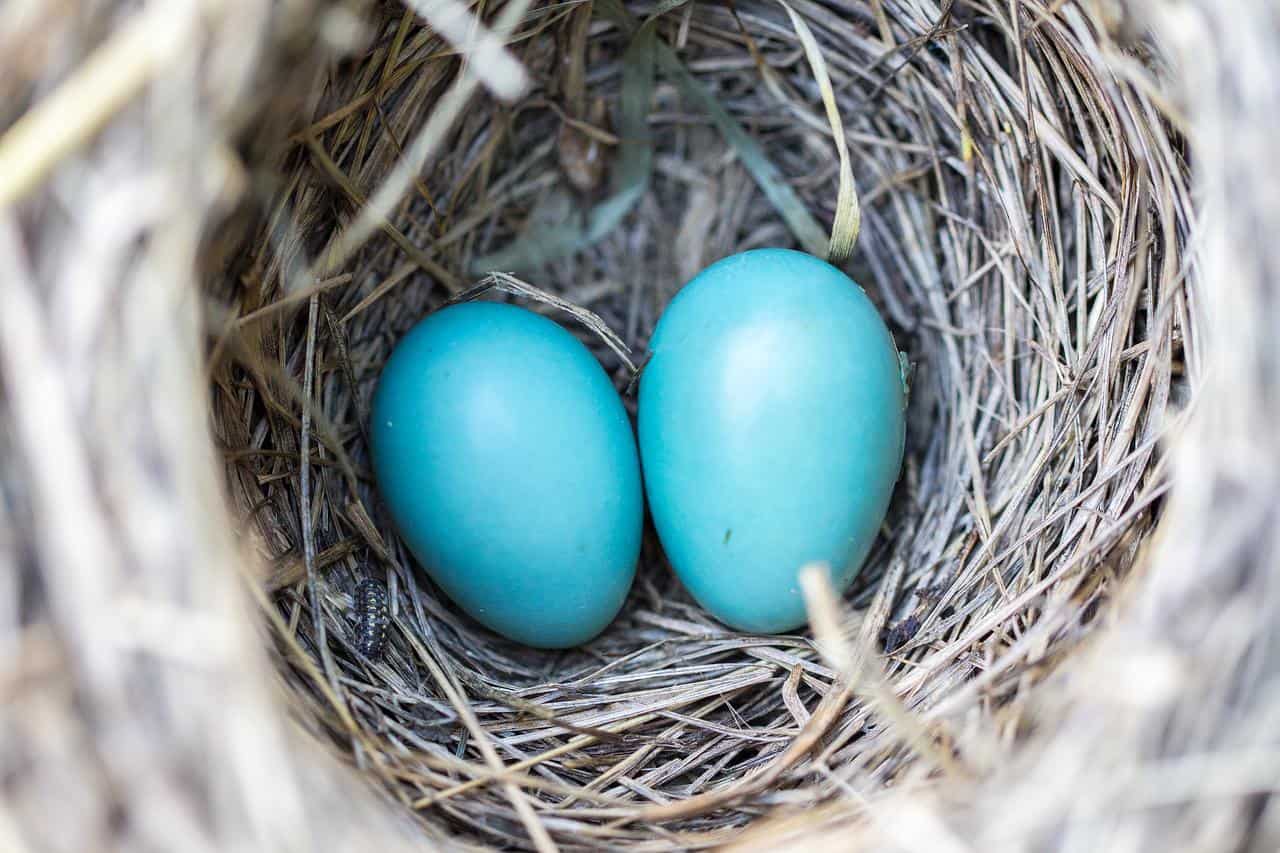Inside: A complete guide to birds that lay blue eggs. These are common birds in North America that lay eggs that are some shade or hue of blue. Discover the species that lay these blue eggs, photos of each bird, and information about each one for fast and accurate identification.
So you found a nest with blue eggs, or perhaps a blue egg on the ground, and would like to identify the parents. You’ve come to the right place because I’ve included all of the common birds that lay blue eggs. Pale blue, bright blue, turquoise-blue, blue-green eggs – they’re all here along with descriptions of the birds.
Over my 20 years of backyard birding, I’ve encountered numerous bird nests with blue eggs. Usually, they’re an Eastern Bluebird or American Robin because they’re most prevalent where I live – in Wisconsin. So, I can easily identify these birds’ eggs and nests.
Still, there are at least 14 more species of common birds that lay blue eggs throughout North America. I’ve researched each one using a Cornell University Lab’s ornithological website (either AllAboutBirds.org or eBird.org) or The Audubon Society’s website to bring you accurate information.
Get read to identify that blue bird egg you’re interested in!
how many birds lay blue eggs
There are well over 20 different bird species in North America that lay blue eggs. As far as common birds go – the ones you could expect to see in and around your yard – there are only about 16 different species of birds including:
- American Crow
- American Goldfinch
- American Robin
- Blue Grosbeak
- Blue Jay
- Cassin’s Finch
- Eastern Bluebird
- European Starling
- Gray Catbird
- House Finch
- Lesser Goldfinch
- Mountain Bluebird
- Northern Mockingbird
- Red-Winged Blackbird
- Varied Thrush
- Western Bluebird
In the next section, I provide more detail about the bird that lays the blue eggs so you can quickly identify the species of bird by the egg color & size, the number of eggs you could expect to see in the clutch, the nest appearance, the habitat in which the egg or nest was found, and the adult bird’s appearance.
Common Birds that Lay Blue Eggs
American Crow
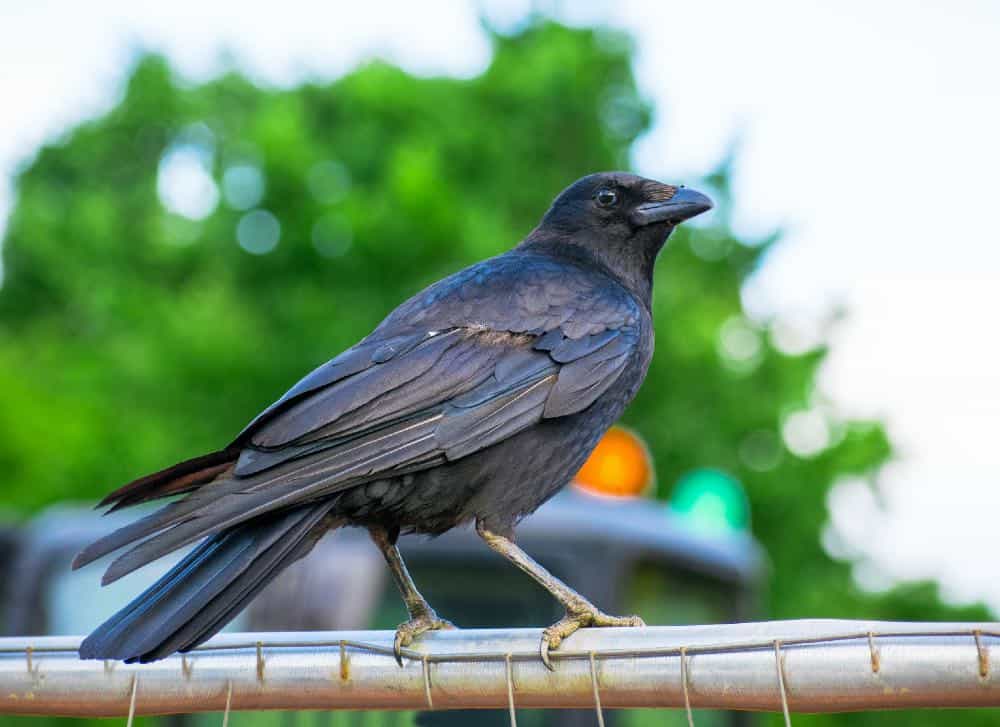
| Appearance | Large all-black bird about 16-20″ long, wide neck with a long straight bill. Male and females have the same appearance. |
| Diet | Opportunistic scavengers eat just about anything they can find on the ground – especially garbage. Natural living fare includes insects, spiders, frogs, snakes, and other birds’ eggs & young. |
| Feeder Food | Not likely to visit a feeder. |
| Habitat | Common birds found in every contiguous US state and most of Canada. Types of habitat include fields, open wooded and forested areas, river edges, shores, towns, cities, parks, and more. The only place you won’t find them is in the hot desert. |
| Nesting | Nest: Builds nests in a large shrub or tree as high as 20′ Broods: 1-2 broods/season Clutch: 3-9 eggs per brood Egg color: Ranging from brighter blue-green to a dull green or blue-gray with heavy gray and brown blotching Egg size: 1.4 – 1.9 inches by 1 inch Incubation: Both parents incubate the eggs for about 18 days. |
Nest & Eggs
Range Map
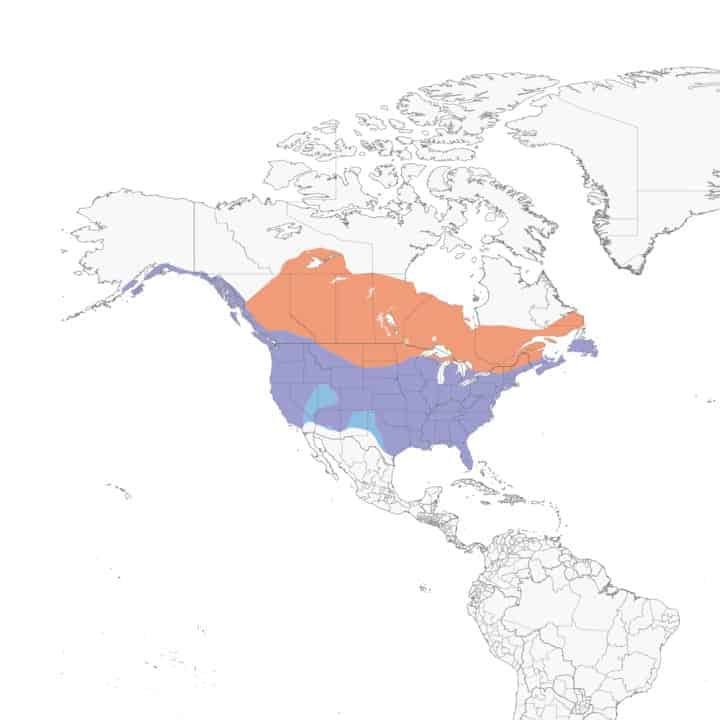
American Goldfinch
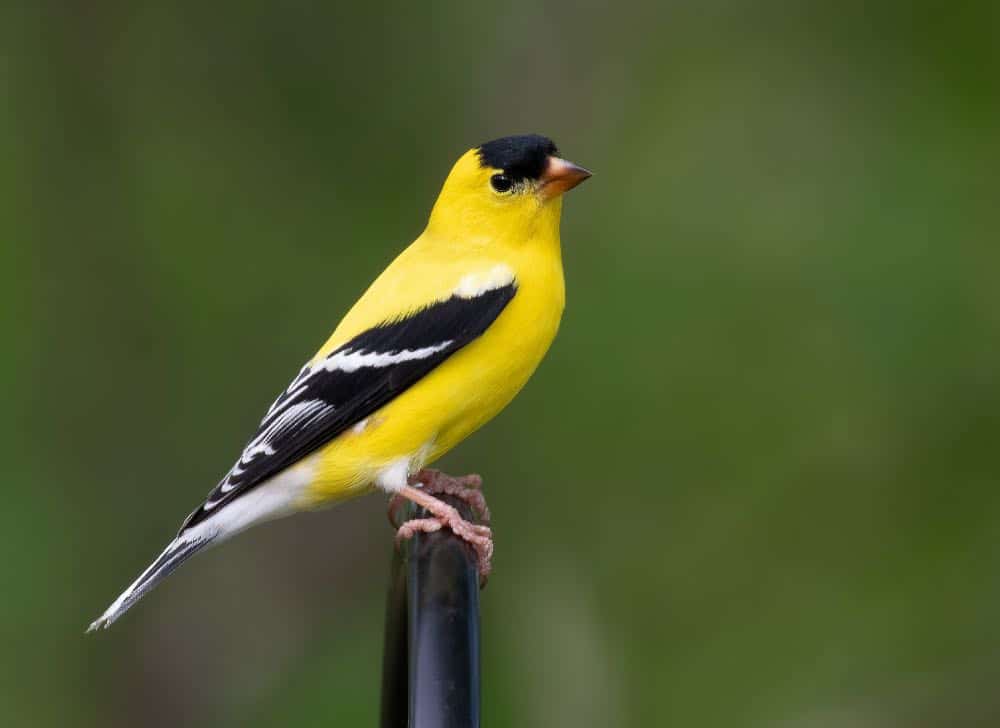
| Appearance | Small bird about 4.5″ long, bright yellow body, black wings with white stripes, black forehead, short orange beak. During winter has a dingy brown body, duller yellow head, and thicker white stripes on its wings. Breeding females are similar to males except their bodies are lemon yellow and wings have more white tips |
| Diet | Seeds from flowers, weeds, grasses, and small trees. Some insects. |
| Feeder Food | Thistle seed (Nyjer) |
| Habitat | Common bird throughout contiguous US and southern part of Canada. Weedy fields, roadsides, orchards, and backyards. |
| Nesting | Nest: Builds nest in deciduous shrub or tree, sometimes conifers, placed on branch’s fork as high as 20′ Broods: 1-2 broods/season Clutch: 2-7 eggs per brood Egg color: Very pale blue to white, occasionally faint brown spots on the larger end. Egg size: 0.5 inches by 0.5 inches Incubation: The female incubates the eggs for about 12-14 days while the male brings food to the female. |
Nest & Eggs
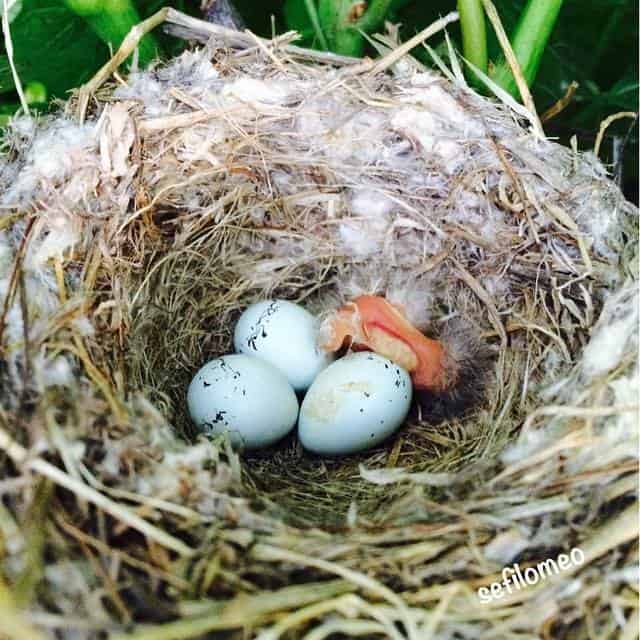
Range Map
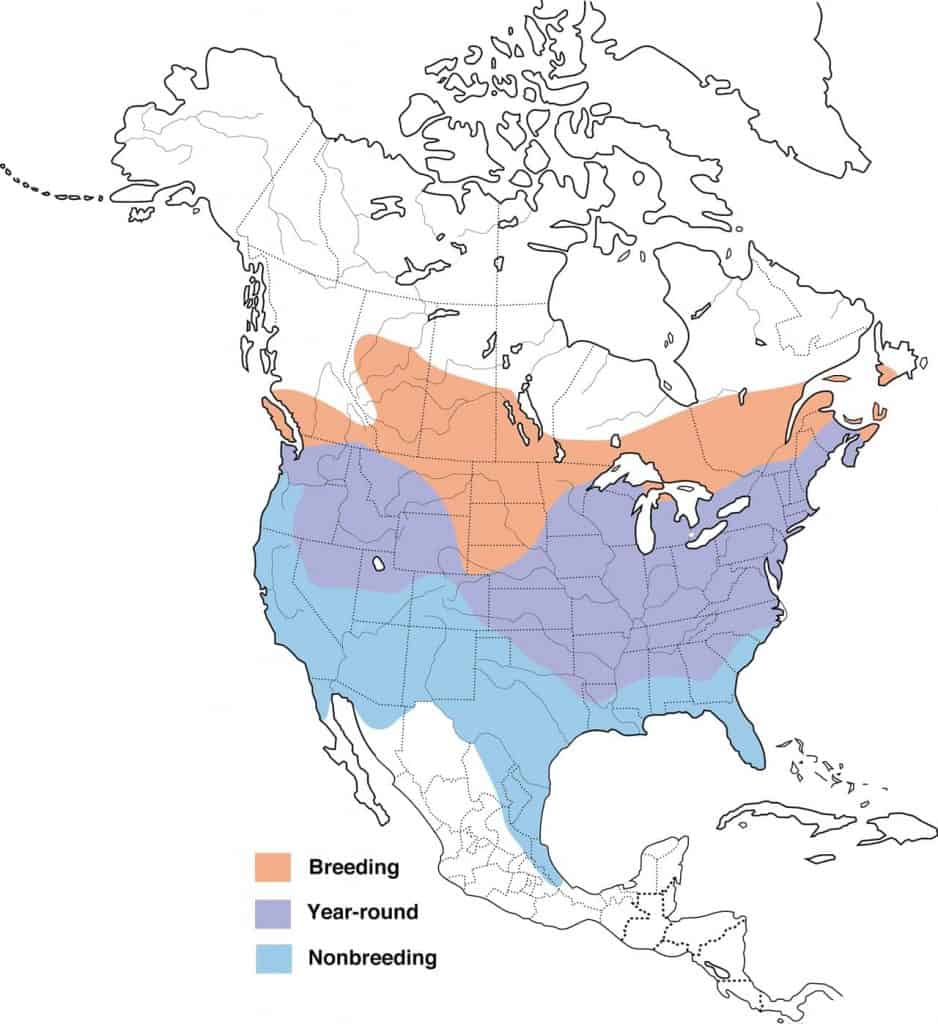
American Robin
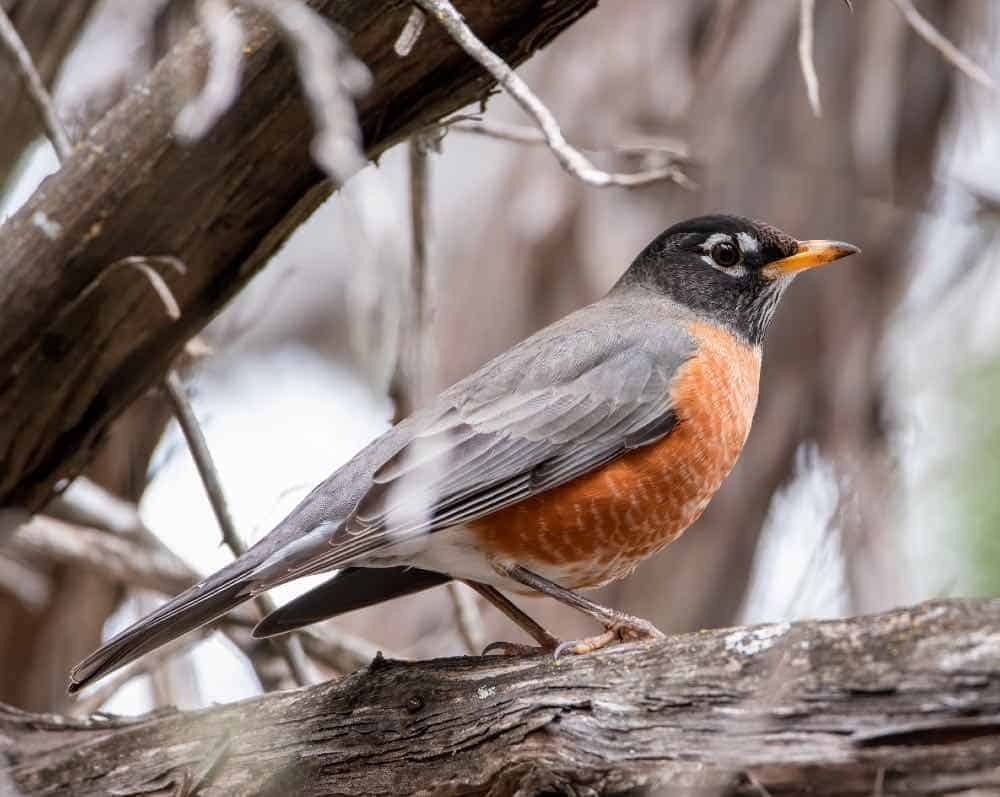
| Appearance | Medium-size bird about 10″ long, gray/brown upper, brown/orange underparts, yellow beak, white chin, white surrounding eyes. orange beak. The Female has a lighter head and underparts. |
| Diet | Earthworms, insects, and fruit. |
| Feeder Food | Not a feeder visitor. |
| Habitat | Common and pervasive throughout US and Canada. Found in fields, parks, wooded and forested areas, mountains, and backyards. |
| Nesting | Nest: Nesting sites vary from the lower half of a tree to rain gutters, outdoor lights, and more. Broods: 1-3 broods/season, Clutch: 3-5 eggs/brood, Egg color: Bright sky blue or blue-green, without spots Egg size: 1.1″ long x 8″ wide Incubation: 12-14 days. |
Nest & Eggs
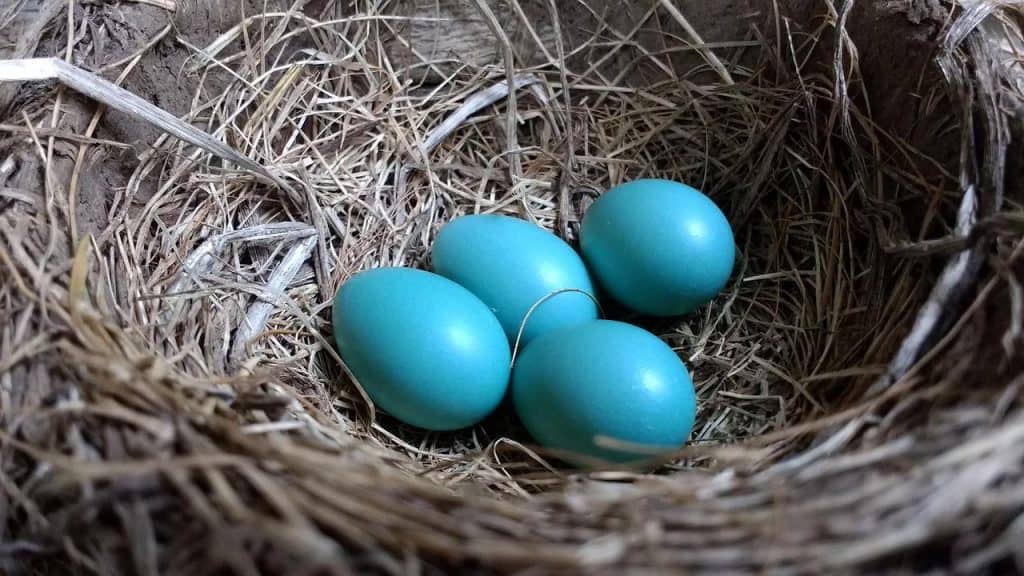
Range Map
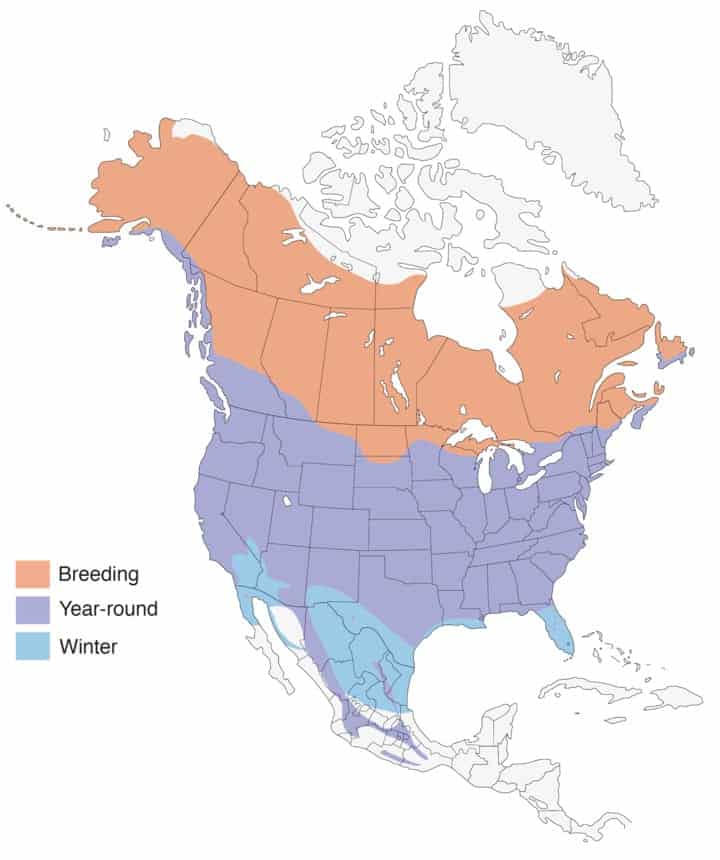
Blue Grosbeak
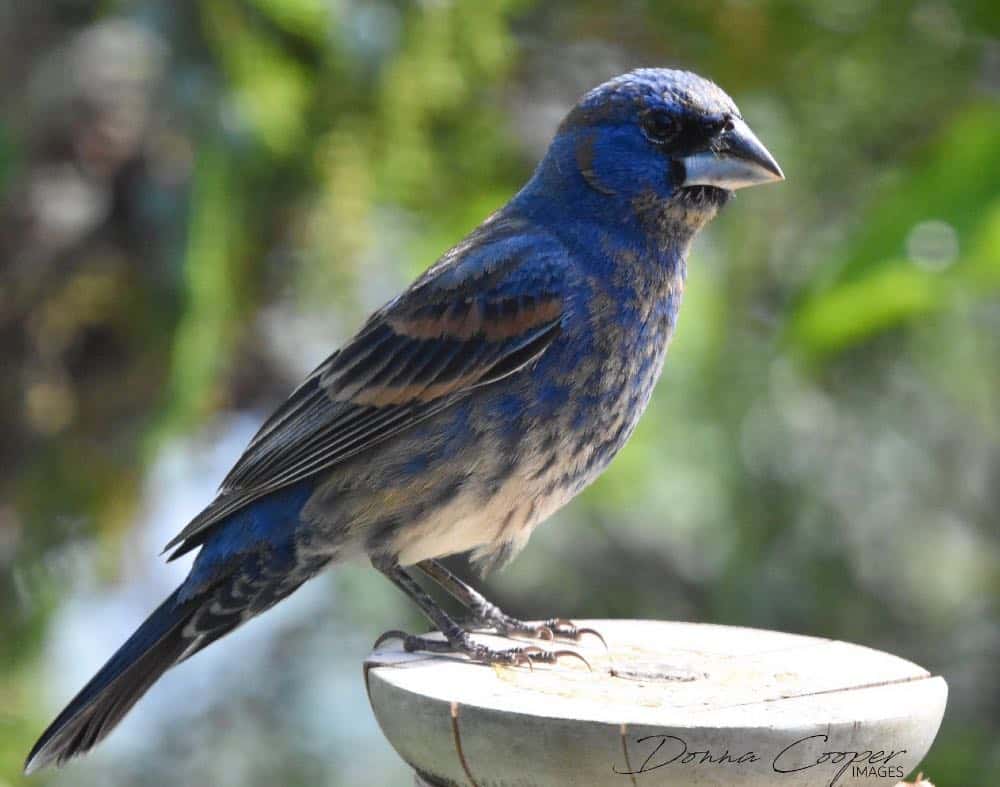
| Appearance | 8″ long, large, bright blue, large silver bill, and chestnut wingbars, Female’s primary color is light cinnamon with darker colored wings. |
| Diet | Insects, seeds, and grains. |
| Feeder Food | Grain and birdseed. |
| Habitat | Thick shrubbery and areas with tall trees. |
| Nesting | Nest: Small cup-shaped nest of twigs and miscellaneous organic materials resting in low-lying trees, shrubs, and bushes. Brood: 1-2 broods/season Clutch: 3-5 eggs/brood Egg color: Pale blue to white with occasional brown spots Egg size: 0.8 inches by 0.7 inches Incubation: 12-13 days incubation. |
Unfortunately, I was unable to provide a photo of the Blue Grosbeak’s nest or eggs.
Range Map
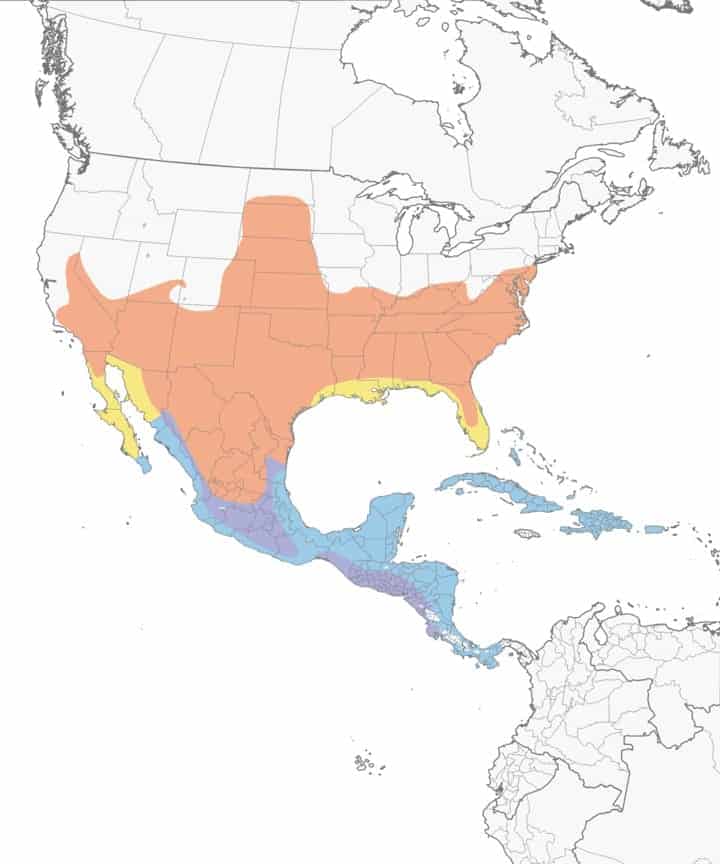
Blue Jay
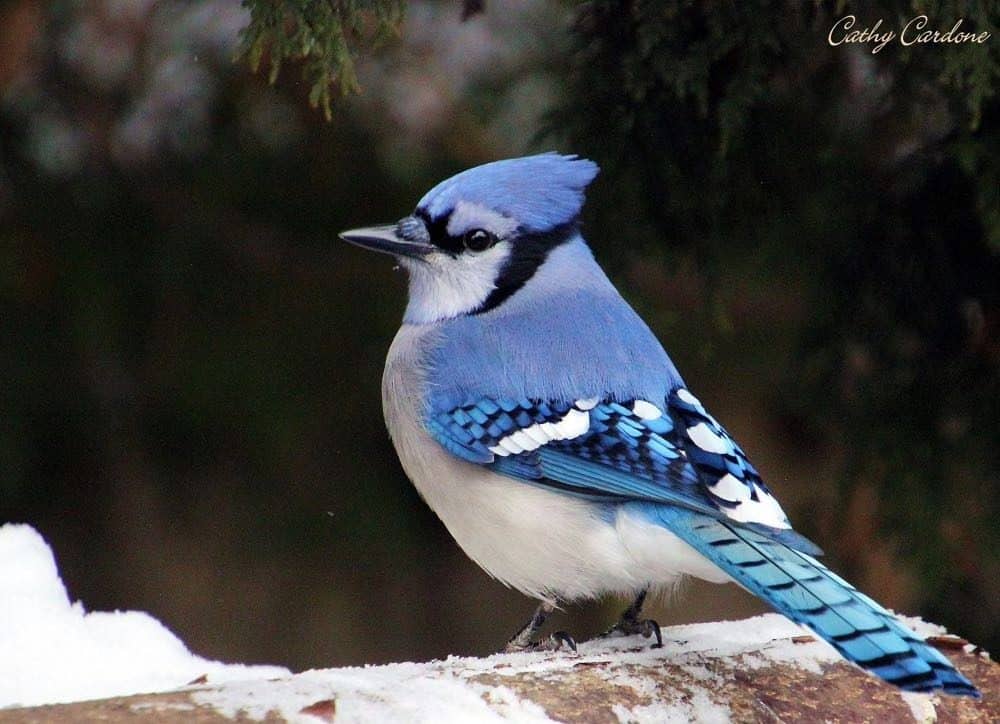
| Appearance | Large bird 12″ long, medium blue & white body, blue crest (which he flattens at will), gray belly, and white face. White & blue wings with black spots. Females look the same. |
| Diet | Insects, fruit, seeds, nuts, other birds’ eggs, and nestlings. |
| Feeder Food | Whole peanuts, sunflower seeds, and cracked corn. |
| Habitat | Forested areas with mixed tree types. Also common in suburbs and urban areas. |
| Nesting | Nest: bulky large nest made from twigs, bark, and mud resting on a tree branch about 5-50′ up. Broods: 1-2 broods/season, Clutch: 2-7 eggs/brood, Egg color: Pale blue to a light brown base color, and these eggs usually have brown or gray spots. Egg size: 1 inch by just under 1 inch Incubation: Both parents incubate the eggs for 17-18 days and the young fledge between 17-21 days. |
Nest & Eggs

Range Map
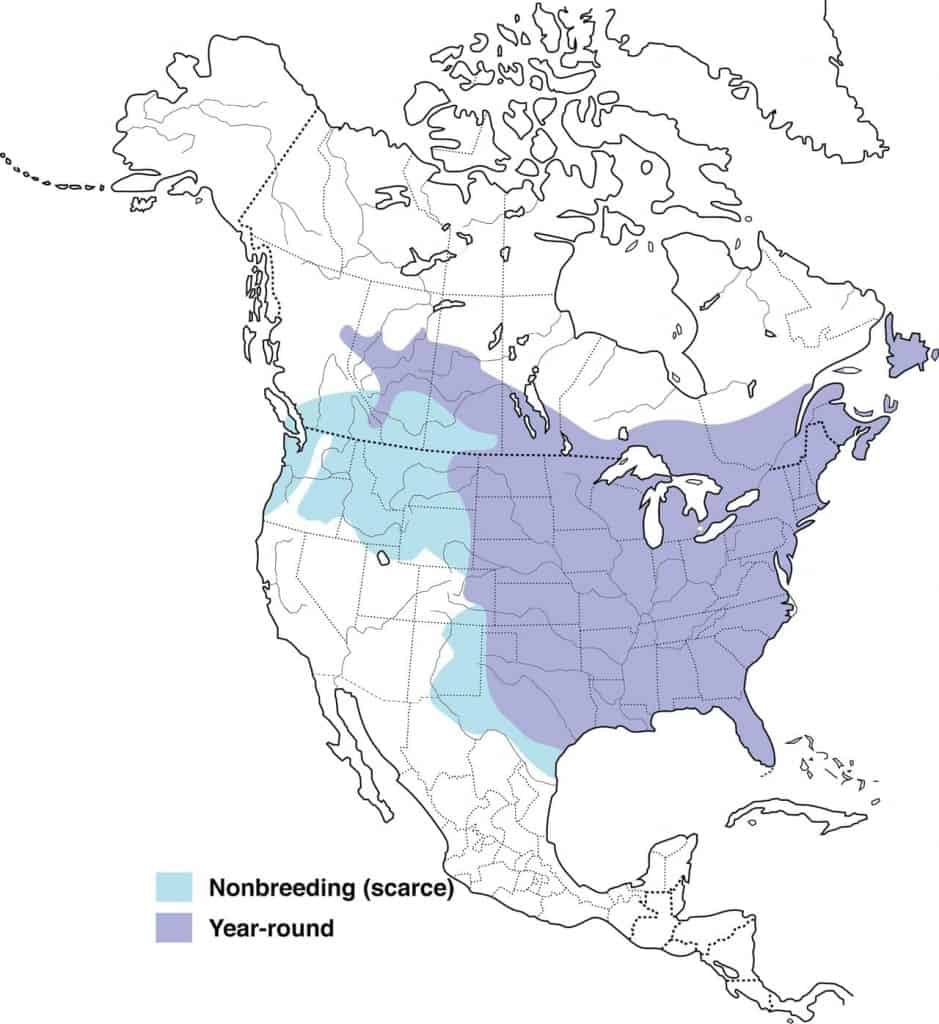
Wouldn’t you love to have blue jays in your yard? Check out: 7 Proven Ways to Attract Blue Jays to Your Yard.
Cassin’s Finch
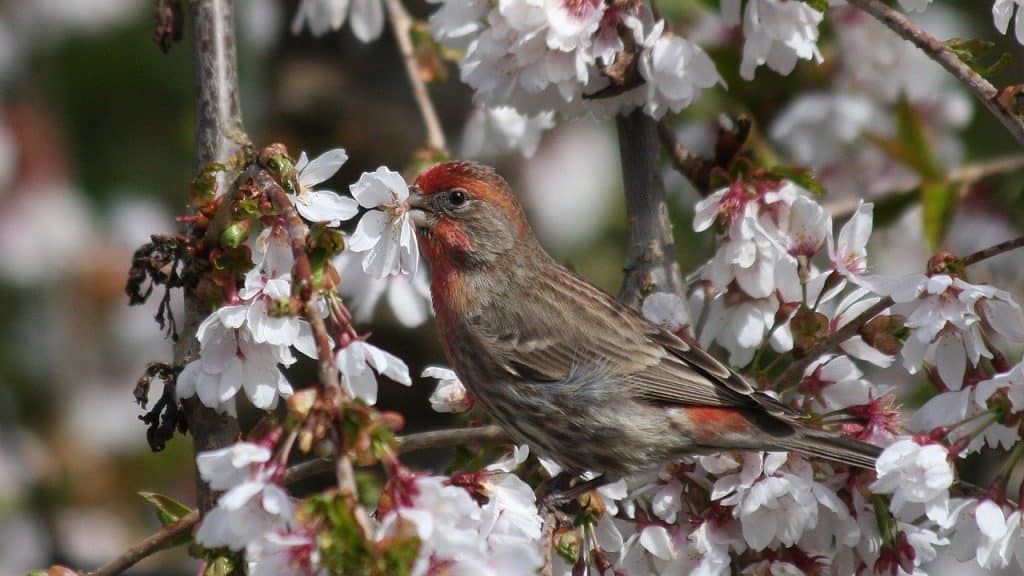
| Appearance | The Cassin’s finch is a small bird about 6 1/4″ long. They’re brown with a red cap, brown stripe across their cheeks, and white underneath with light pink streaks on the chest. The female is similar except she doesn’t have red or pink. her chest and belly are heavily streaked brown and she has a white streak above and over her eyes. |
| Diet | Seeds, buds, and berries. Occasionally insects. |
| Feeder Food | Black-oil sunflower seeds. |
| Habitat | Open forested areas rich with conifers. |
| Nesting | Nest: They build a nest high up in a conifer – about 30+ feet up. Broods: 4-5 eggs/brood Clutch: 3-6 eggs/brood Egg color: Light bluish with black, brown, and purplish speckles Egg size: 0.7 – 0.8 inches by 0.5 – 0.6 inches Incubation: 12-14 days. |
Unfortunately, I was unable to provide a photo of Cassin’s Finch nest or eggs.
Range Map
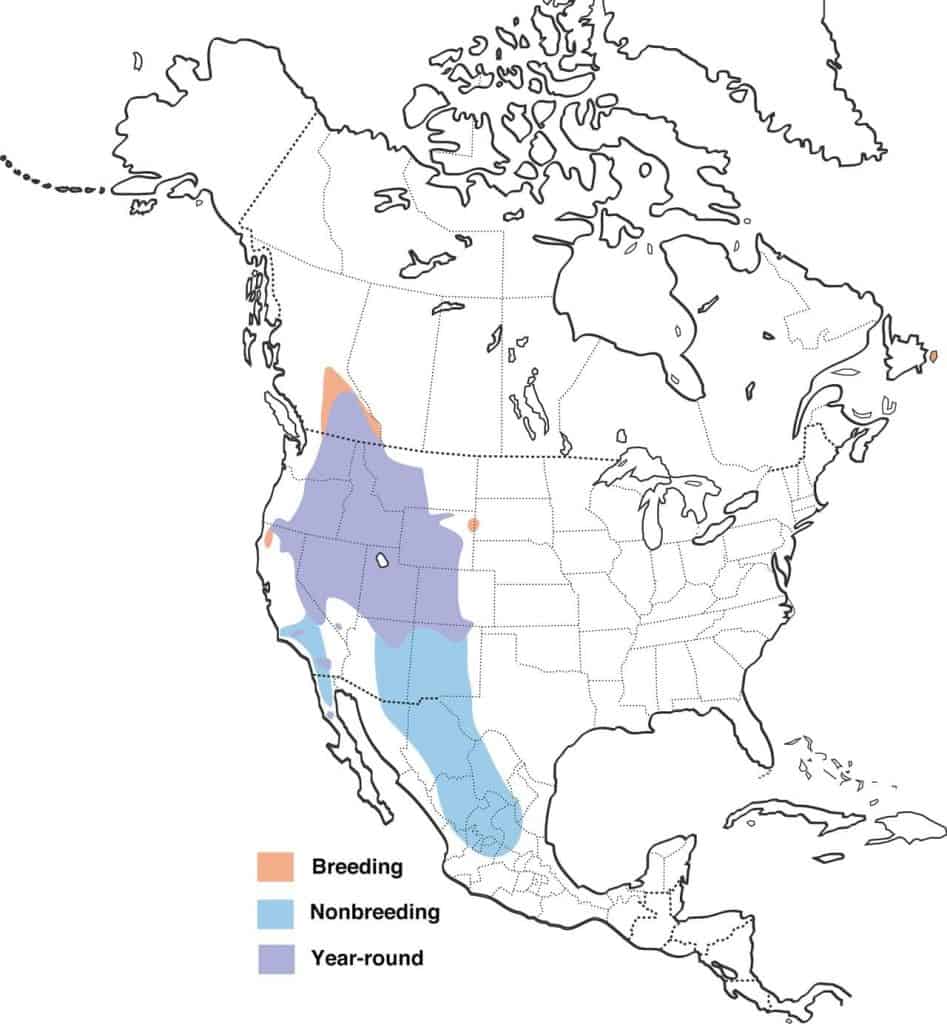
Eastern Bluebird
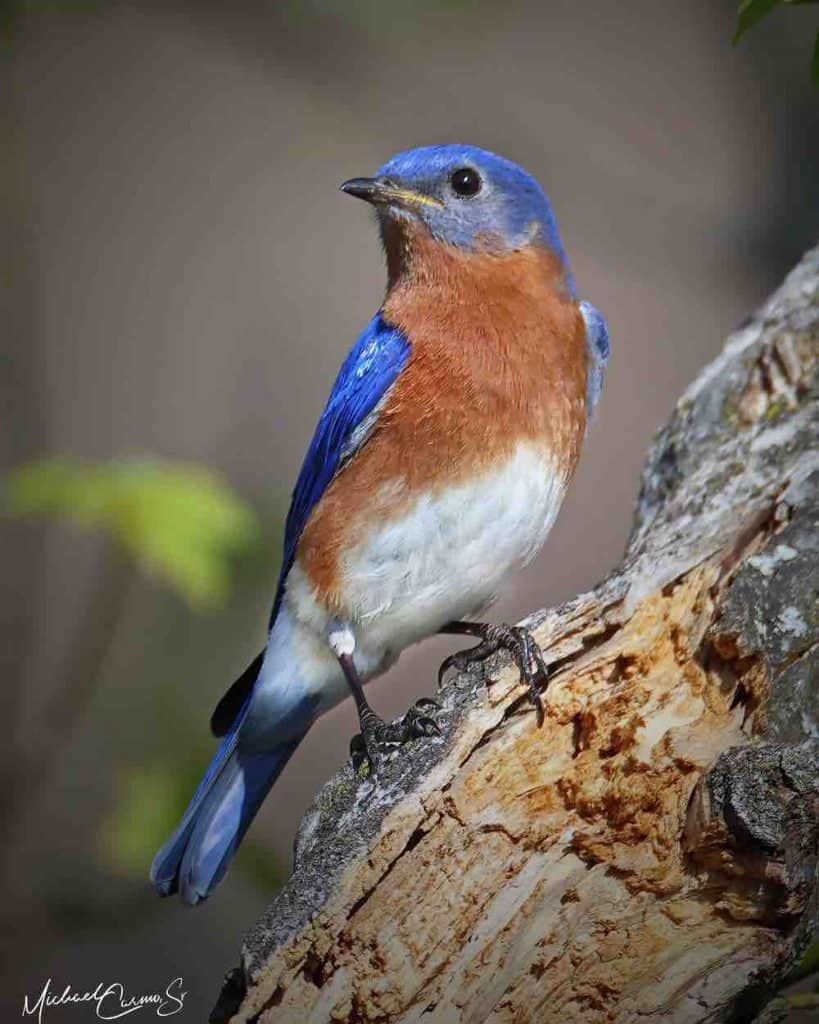
| Appearance | 7″ long, royal blue, orange throat & breast, white belly & undertail. Female is similar but more muted colors |
| Diet | Insects & spiders in spring/summer. Small fruit in Fall/Winter. |
| Feeder Food | Suet, sunflower seeds, dried fruit, jelly. |
| Habitat | Wide-open spaces, fields, meadow. |
| Nesting | Nest: Cavity nesters. The male bluebird determines the nest site (an old woodpecker hole in a tree or manmade nestbox), but the female is the one who builds the nest. She keeps the nest for multiple broods. Brood: 2-7 broods/season Clutch: 4-5 eggs/brood Egg color: Pale blue eggs (sometimes white) with no blemishes or discoloration. Egg size: 0.9 inches by 0.8 inches Incubation: 11-19 days |
Nest & Eggs
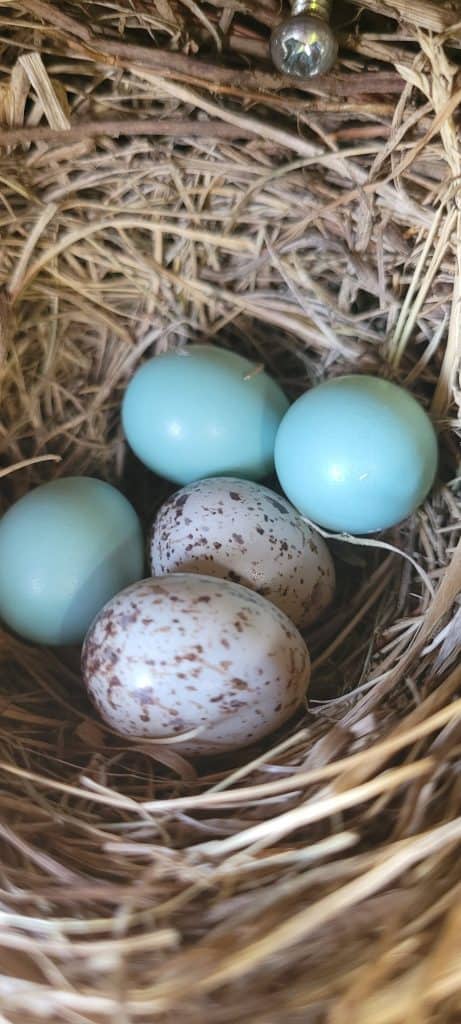
Range Map
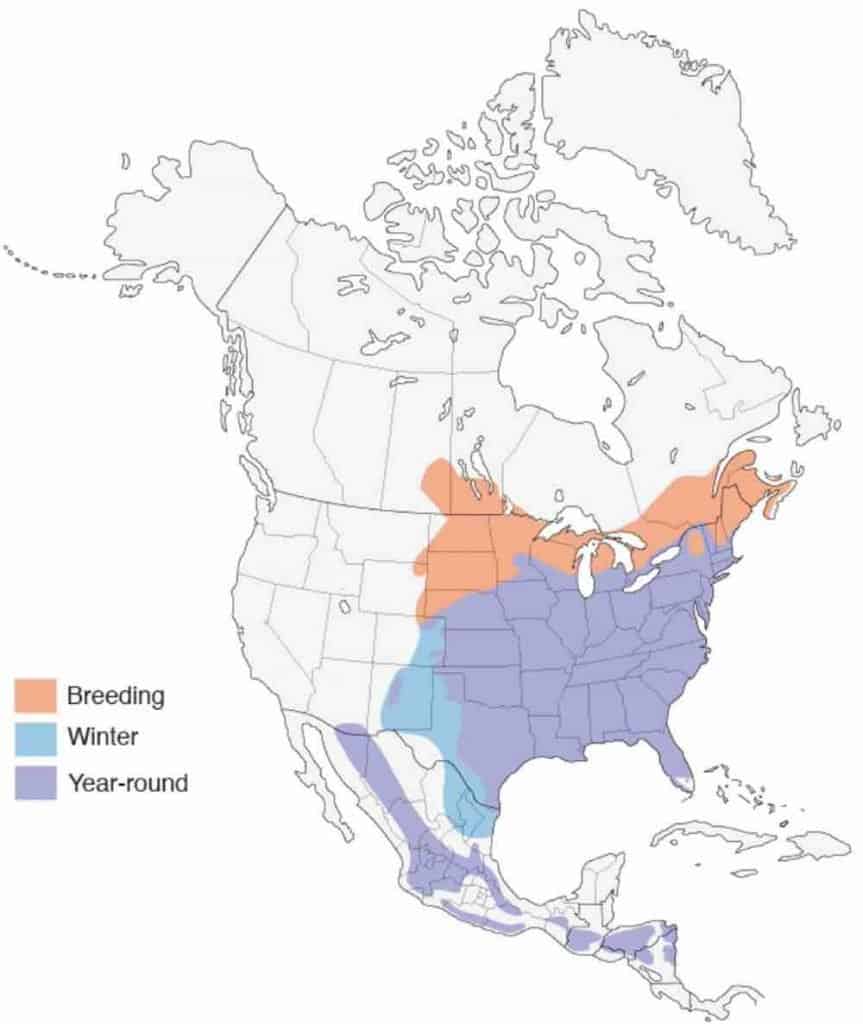
European Starling
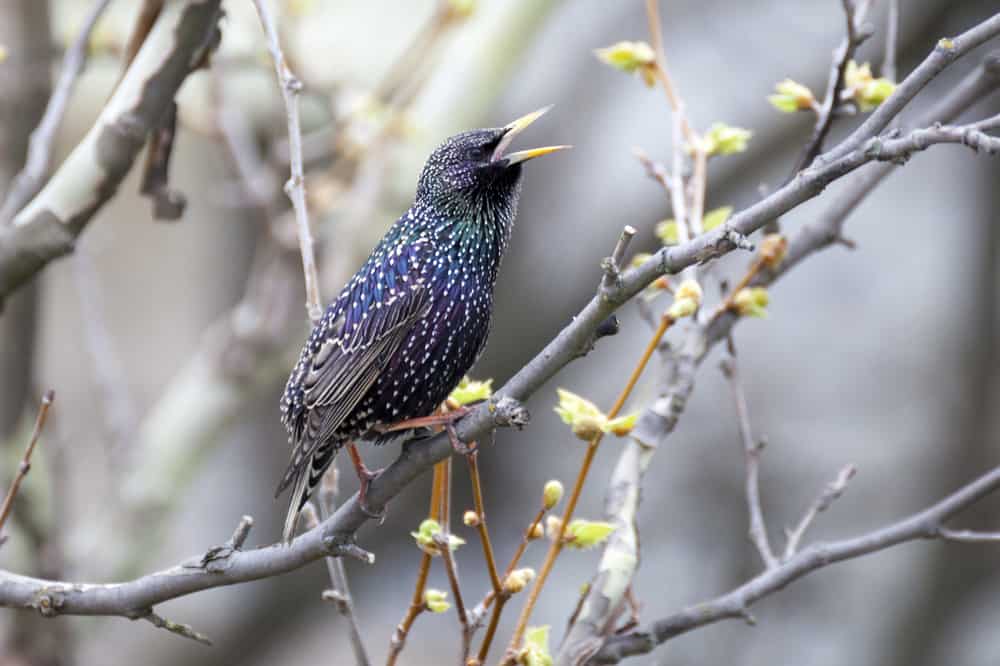
| Appearance | Medium-sized bird about 7 1/2″ long with iridescent shades of purple and black with white speckles throughout. They have a long pointed gray bill in fall and yellow in spring. The tail is short. The Female looks the same. |
| Diet | Insects, seeds, fruit. |
| Feeder Food | Everything and anything you could offer at the feeder. |
| Habitat | Urban and residential areas throughout the US and Canada including backyard lawns, parks, and fields. |
| Nesting | Nest: They are cavity nesters Brood: 2 broods/year. Clutch: 4-6 eggs/brood Egg color: Glossy bluish or a pale green Egg size: 1.1 – 1.3 inches by 0.8 – 0.9 inches Incubation: 12-14 days. |
Nest & Eggs
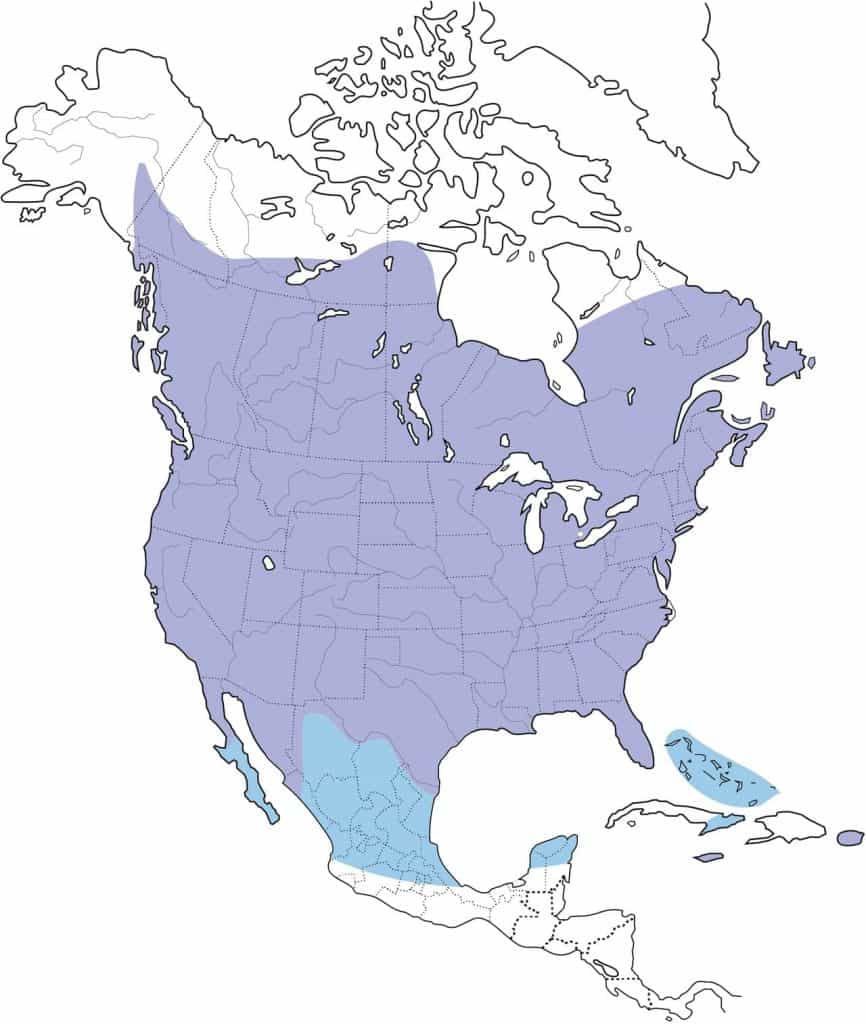
Gray Catbird
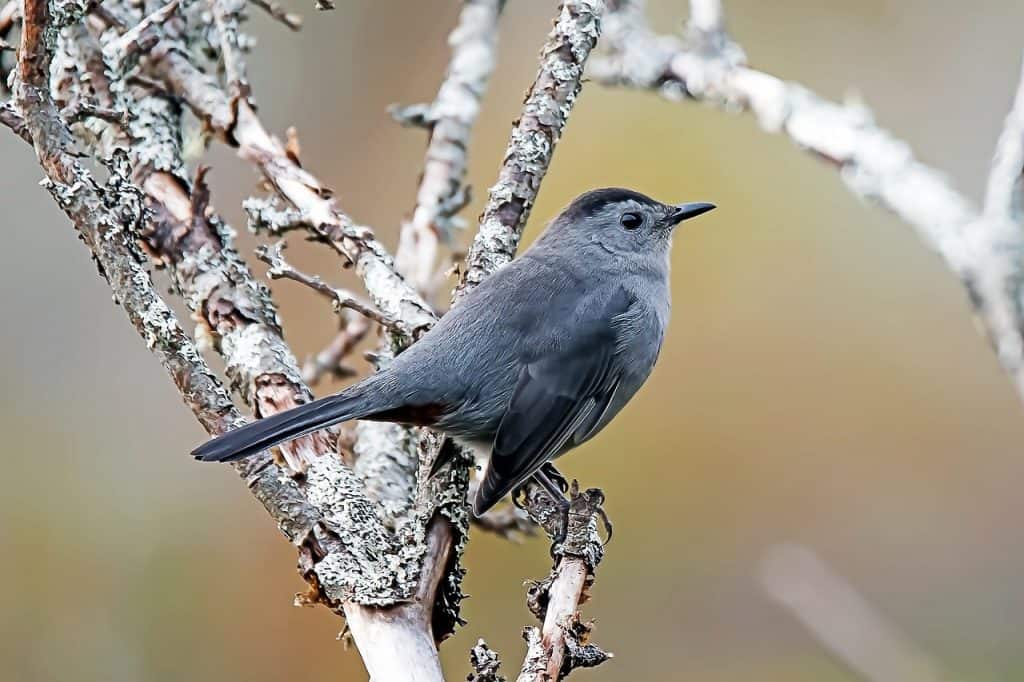
| Appearance | Medium-sized bird about 9″ long. Slate gray with a black crown and dark eyes. Bill is long, thin, and black. Usually concealed, a chestnut patch is under the tail. The female is the same. |
| Diet | Insects and fruit. |
| Feeder Food | Unlikely to visit a feeder. |
| Habitat | Open woodlands. |
| Nesting | Nest: The nest is cup-sized. Broods: 2 broods/year, Clutch: 4-6 eggs/brood Egg color: Bright, turquoise-green sometimes with fine, red spots or no markings. Egg size: 1 inch by 0.5 inches Incubation:12-13 days |
Nest & Eggs
Range Map
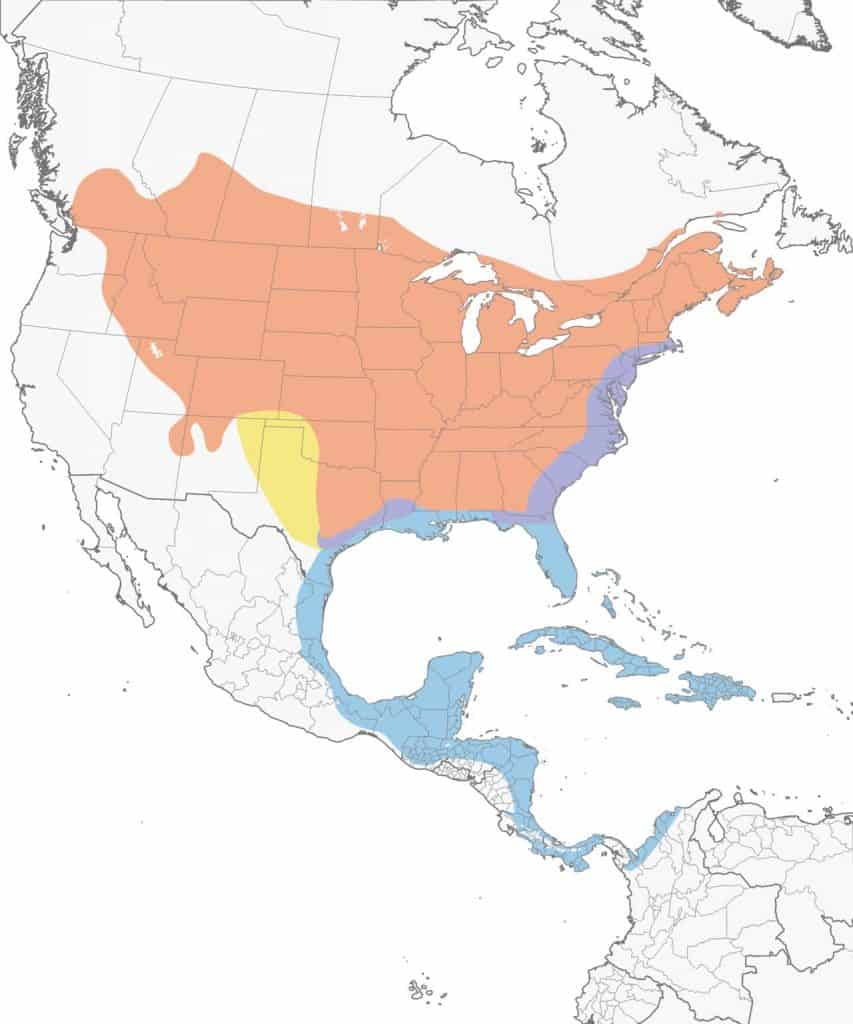
House Finch
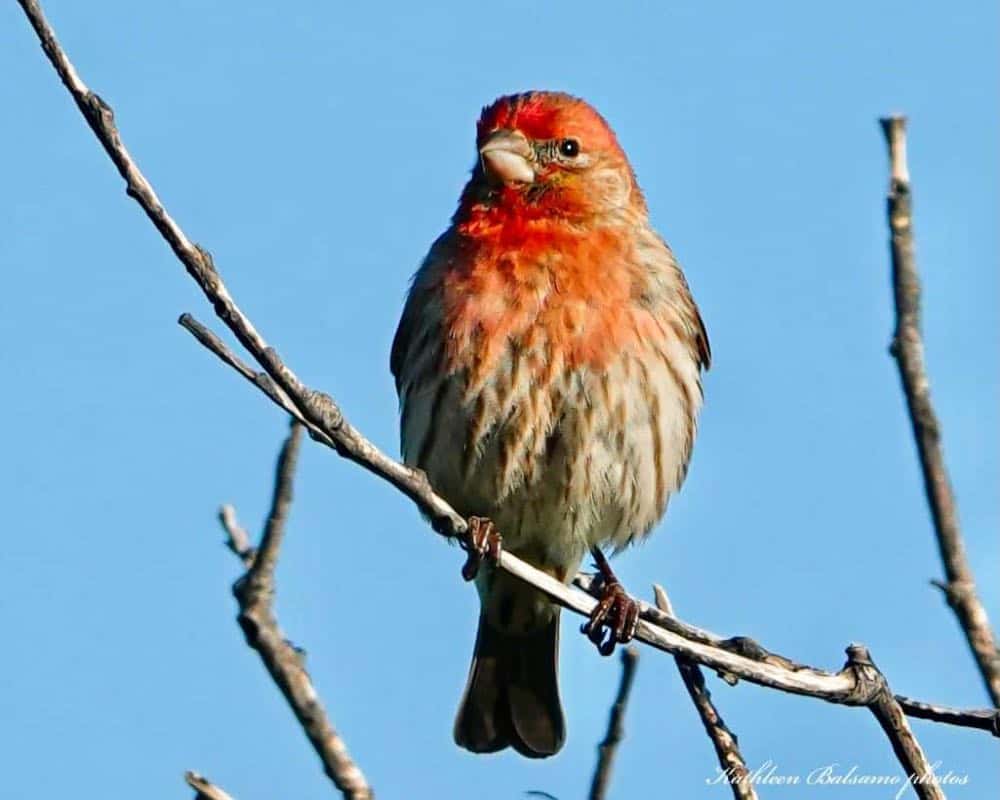
| Appearance | Small bird about 5″ long, orange/red face chest and rump. Brown wings streaked with white. White belly with brown streaks. The Female and juvenile are brown with streaks of white. |
| Diet | Seeds, fruit, tree buds. |
| Feeder Food | Black oil sunflower seed is their favorite. |
| Habitat | House finches are found in the western and eastern parts of the US. They prefer to live around human dwellings (buildings, backyard trees, and shrubs, barns. Also are found in parks and other urban areas. |
| Nesting | Nest: Small cup about 3-7″ wide, constructed from stems, leaves and plant roots, and feathers. The nests are built in coniferous or deciduous trees or even any place that holds a nest (ledges, vents, hanging plants). Broods: 1-6 broods/season Clutch: 2-6 eggs/brood (typical is 4-5) Egg color: Eggs are pale blue and speckled with black and purple dots. Egg size: 0.6 – 0.8 inches by 0.5 inches Incubation: 13-14 days and the young fledge between 12-19 days. |
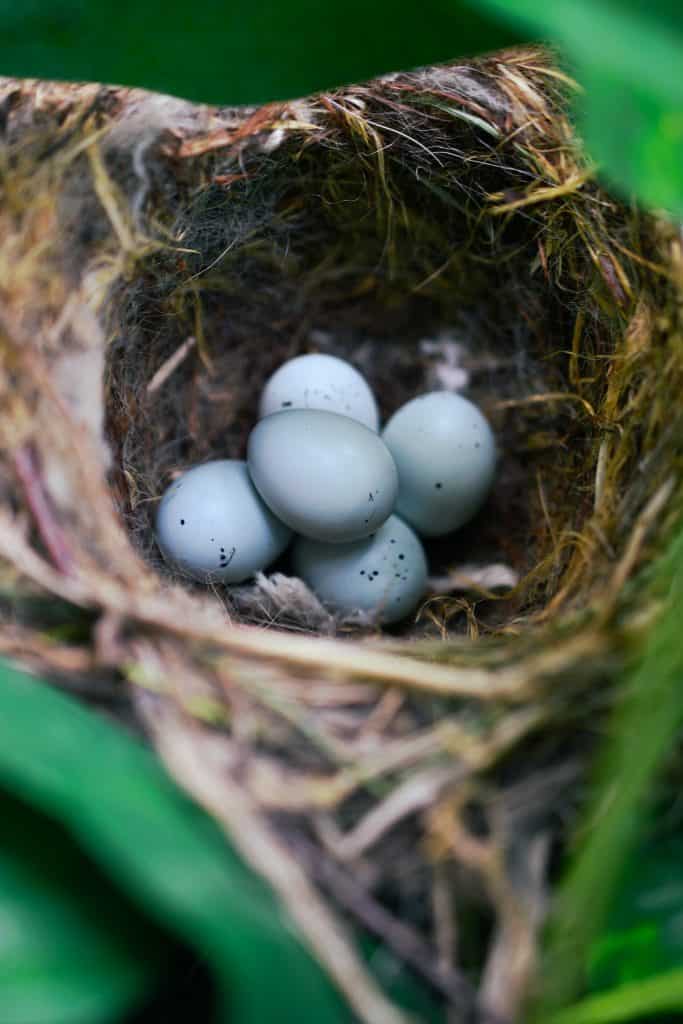
Range Map
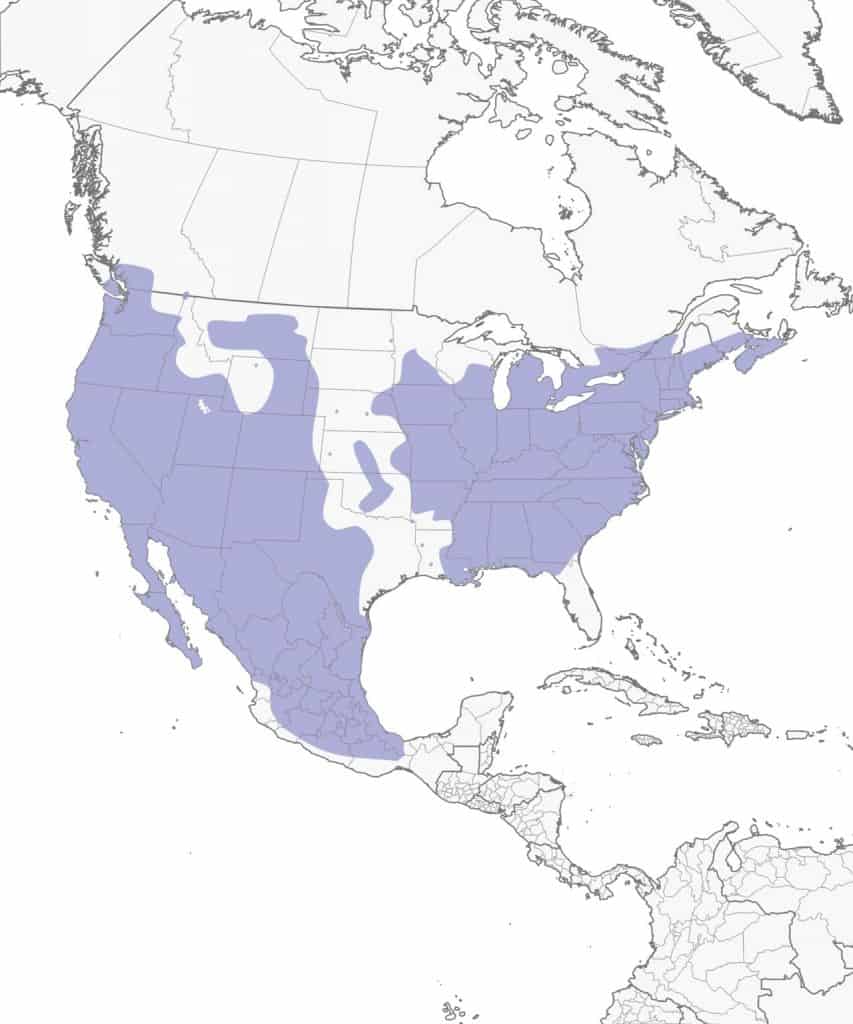
Lesser Goldfinch
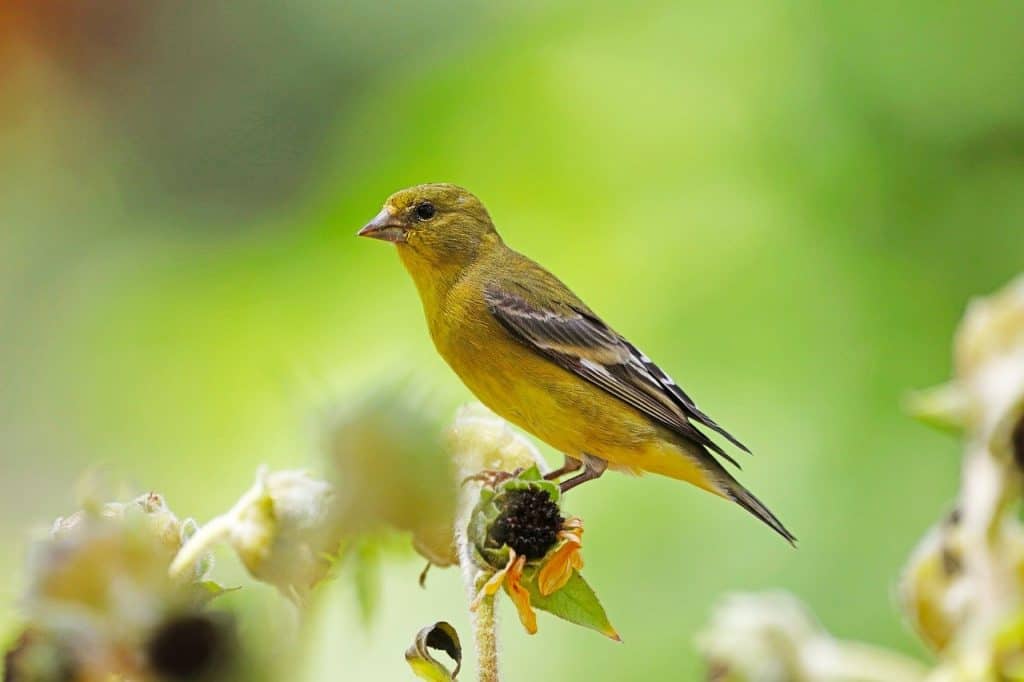
| Appearance | Small bird about 4.5″ long withn olive-green body, yellow belly, and black wings with white patches. There are two sub-species of the lesser goldfinch. • The black-backed is found from Colorado to Texas and has black underparts and a yellow belly. • The green-backed is found in the southwest and west coast and has a black cap but olive-green back and a yellow belly. • The green-backed is found in the southwest and west coast and has a black cap but olive-green back and a yellow belly. The female is the same except a duller olive green. |
| Diet | Seeds, tree buds, berries, and occasionally insects. |
| Feeder Food | Nyjer seed |
| Habitat | Enjoy a variety of habitats at different elevations and can be found in backyards with plenty of seed-bearing vegetation. |
| Nesting | Nest: Lesser goldfinches build a compact cup-shaped nest and place about 50-30′ high in a tree or shrub – typically in forked branches. Broods: 1 brood/season Clutch: 3-6 eggs/brood Egg color: Pale blue-white without markings Egg size: 0.6 inches by 0.4 – 0.5 inches Incubation: 12 days. |
Nest & Eggs
Range Map
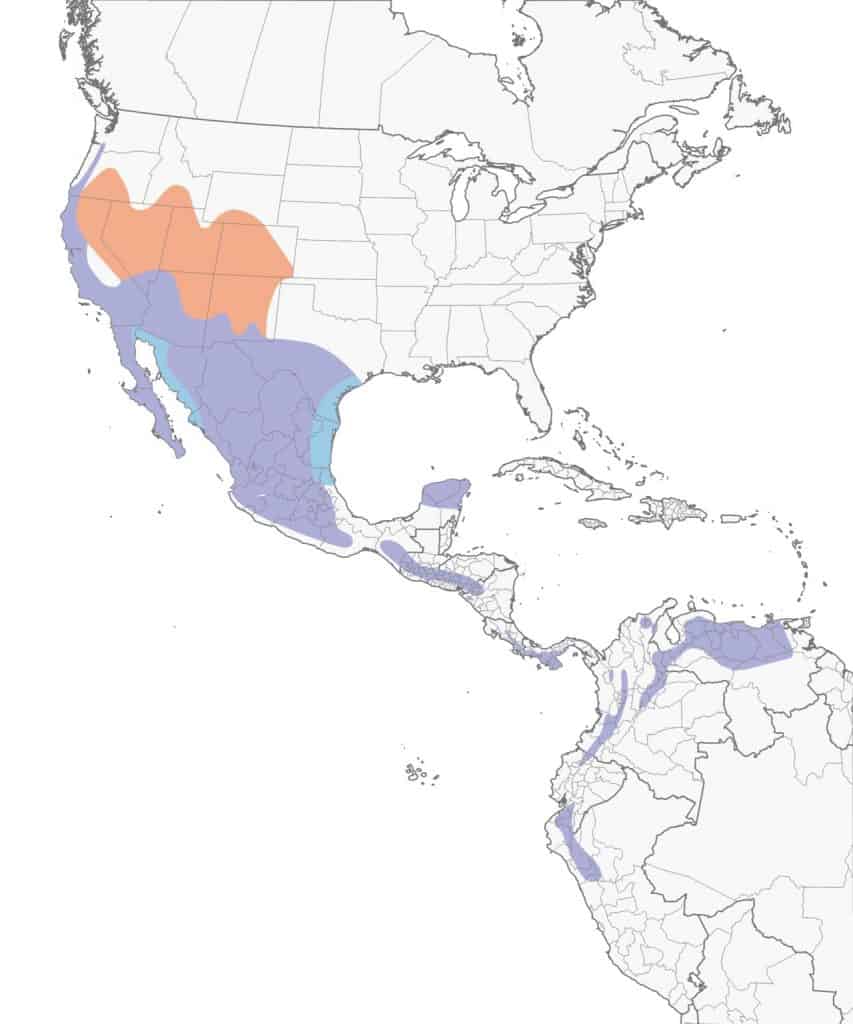
Mountain Bluebird
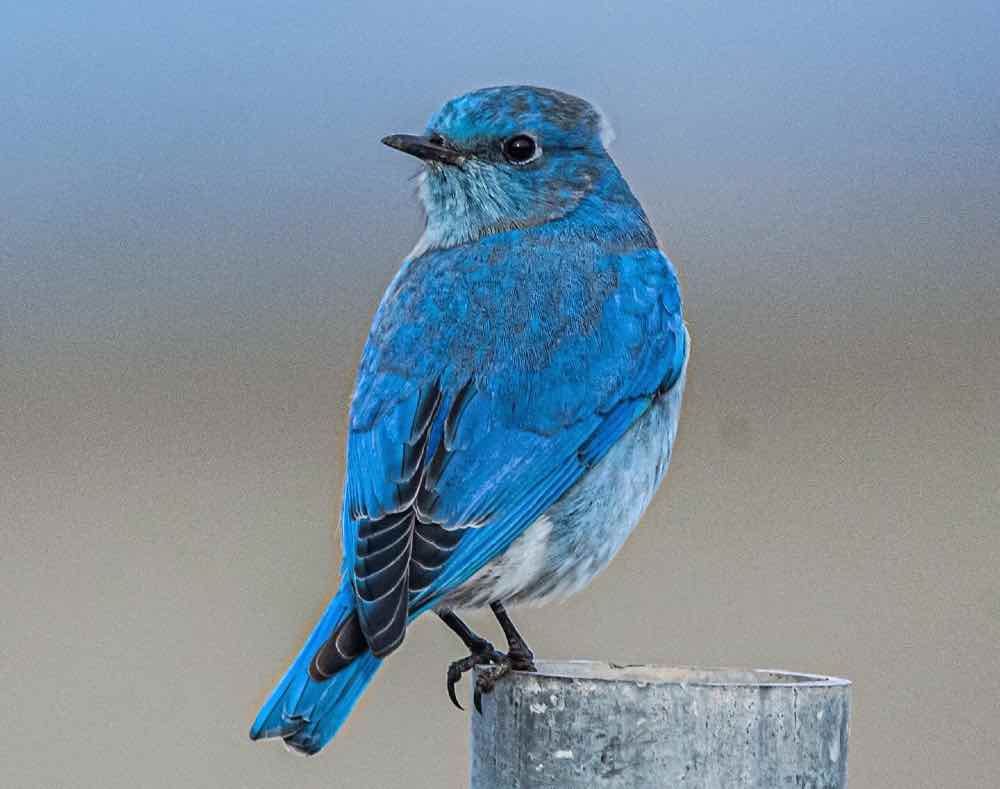
| Appearance | Small bird about 7″ long. Sky-blue color, darker blue wings and tail, lighter shades of below underneath, white undertail with black wing tips, and straight thin bill. Females are gray/brown with a big of soft blue on their wings and tail. |
| Diet | Insects, fruit, and seeds. |
| Feeder Food | Unlikely to visit a feeder. |
| Habitat | Open woodlands, fields, prairies. |
| Nesting | Nest: Cavity nesters – will use an old woodpecker hold or manmade nesting box. Brood: 1-2 broods/season Clutch: 4-8 eggs/brood Egg size: 1″ x .8″ Egg color: Pale blue to bluish-white (rarely pure white) Incubation: 18-21 days |
Nest & Eggs
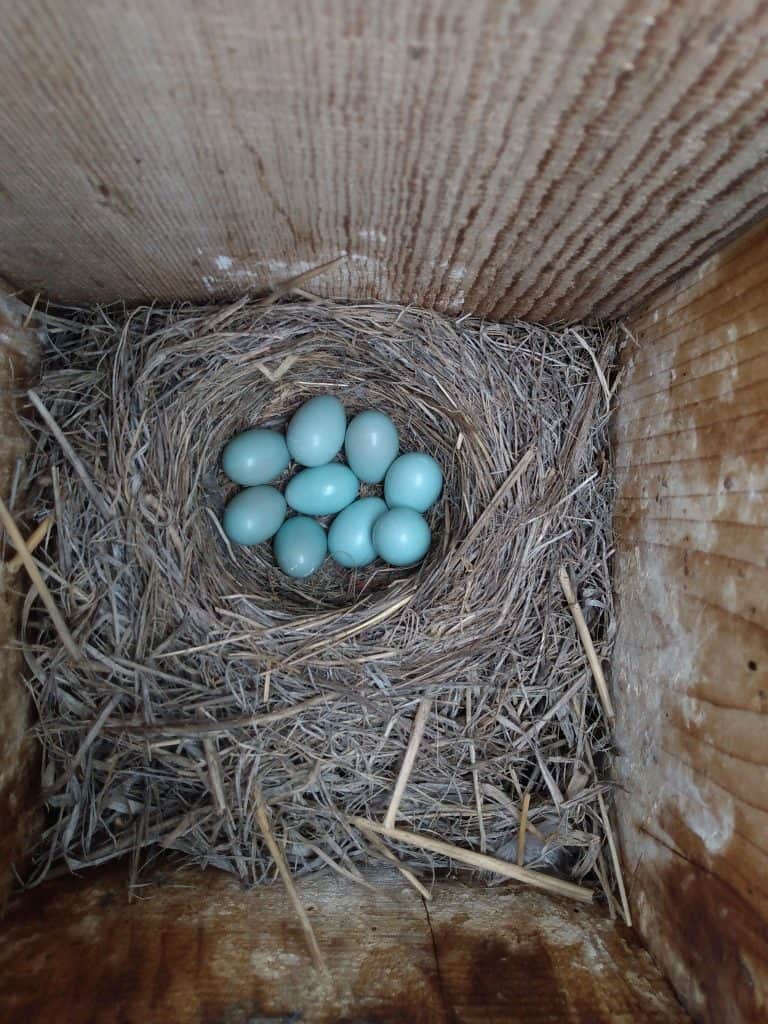
Range Map
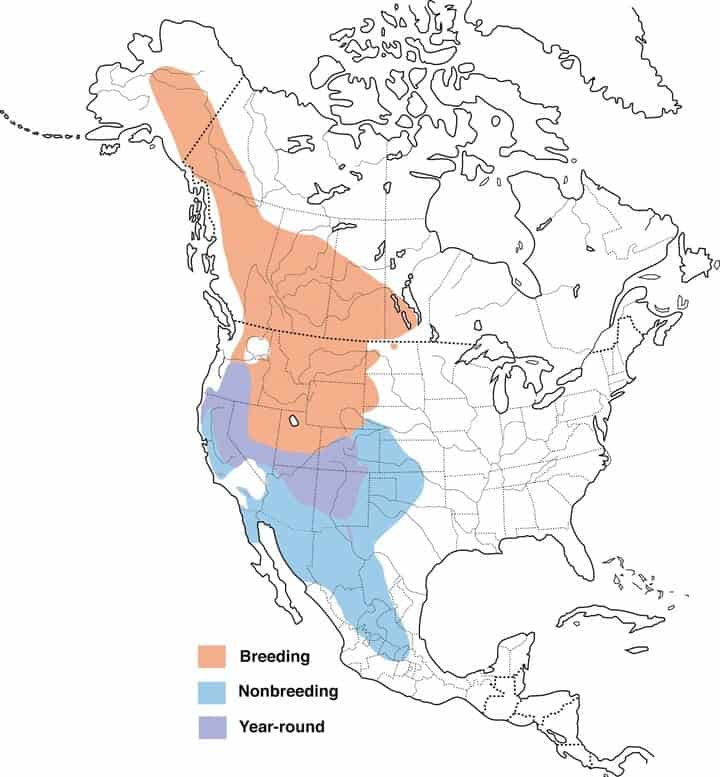
Northern Mockingbird
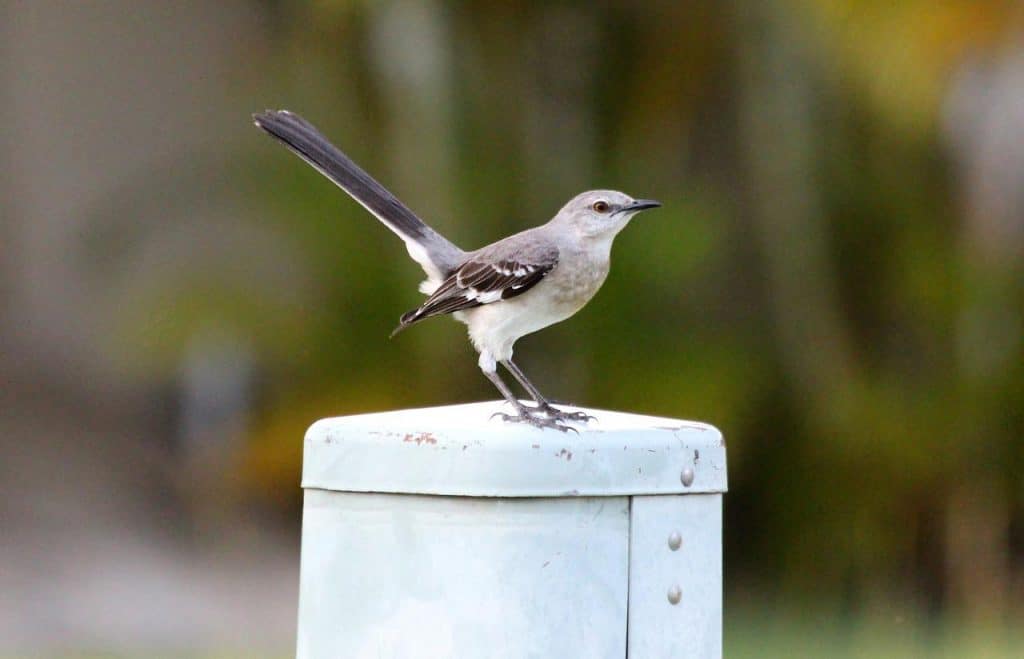
| Appearance | Northern mockingbirds are about 10″ long. They have gray above and white below. Wings are dark gray with patches of white. They have long beaks and yellow eyes. |
| Diet | Insects and berries. |
| Feeder Food | Suet. |
| Habitat | Northern mockingbirds prefer thickets and brushy areas with open areas nearby. |
| Nesting | Nest: They nest in a thick shrub or tree between 1-10′ up. Northern mockingbird males select several nesting sites and begin building nests in each. The female will pick her favorite and finish the nest. They won’t abandon these nests but move to another with each brood Brood: 2-3 broods/season Clutch: 2-6 eggs/brood Egg color: Light blue to greenish-white sporting brown or red spots. Egg size: 1.1 inches by 0.8 inches Incubation: 12-14 days and fledglings leave the nest at 11-15 days. |
Nest & Eggs
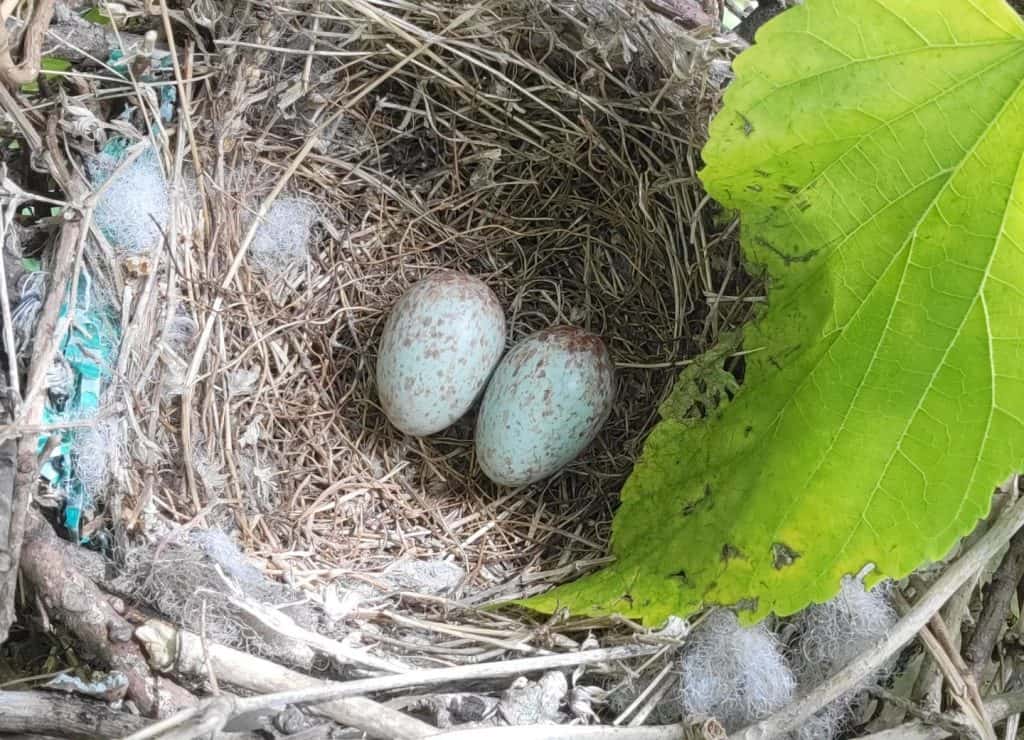
Range Map
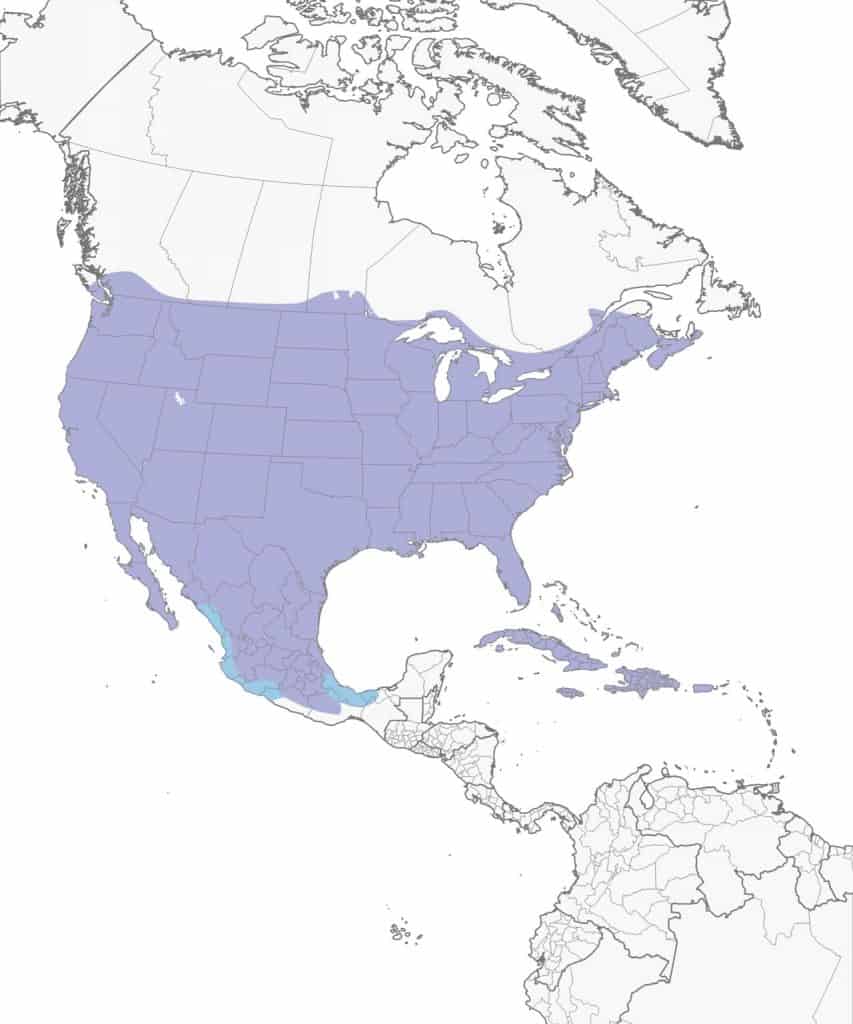
Did you know the Mockingbird is a symbol of adaptability and creativity? When you encounter one it may be trying to encourage you to be open to new ideas or explore your creative potential.
Red-Winged Blackbird
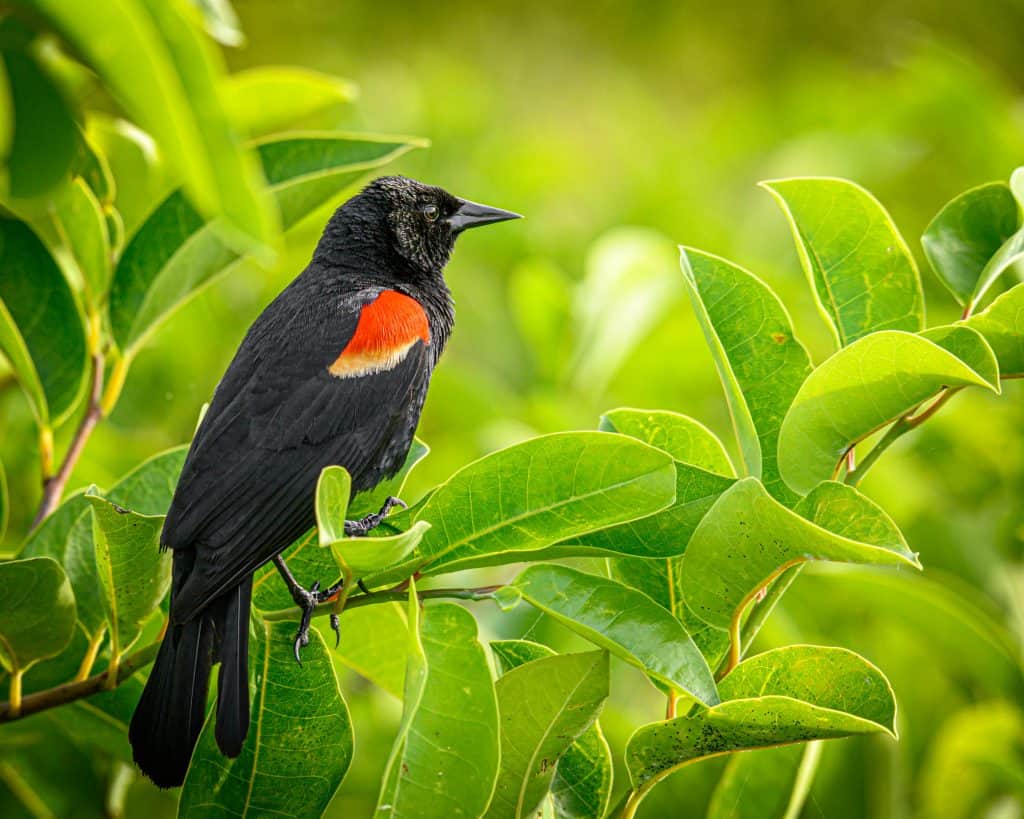
| Appearance | A medium-sized jet black bird about 8 1/2″ long with a red and yellow patch on the shoulder of the upper wing. Pointy black bill. The females are brown and heavily streaked. She has white eyebrows and a brown bill. |
| Diet | Insects, seeds. |
| Feeder Food | Black-oil sunflower seed, hulled sunflower seeds, cracked corn, peanut hearts, millet. |
| Habitat | Wet areas like marshes but also found in meadows, fields, and even wooded edges. |
| Nesting | Nest: Cup-shaped nest located low in shrubs or trees. Broods: 1-2 broods/year Clutch: 2-4 eggs/brood Egg color: Bluish-green to gray with brown or black markings Egg size: 1″ by about .6 – .8″ Incubation: 10-12 days. |
Nest & Eggs
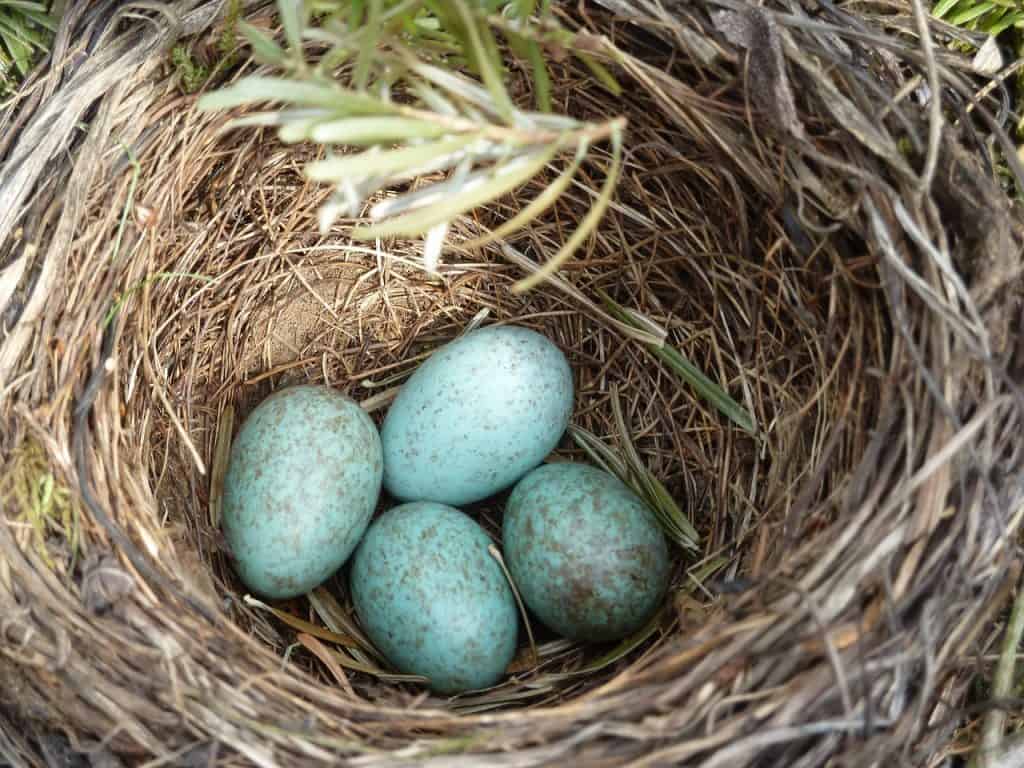
Range Map
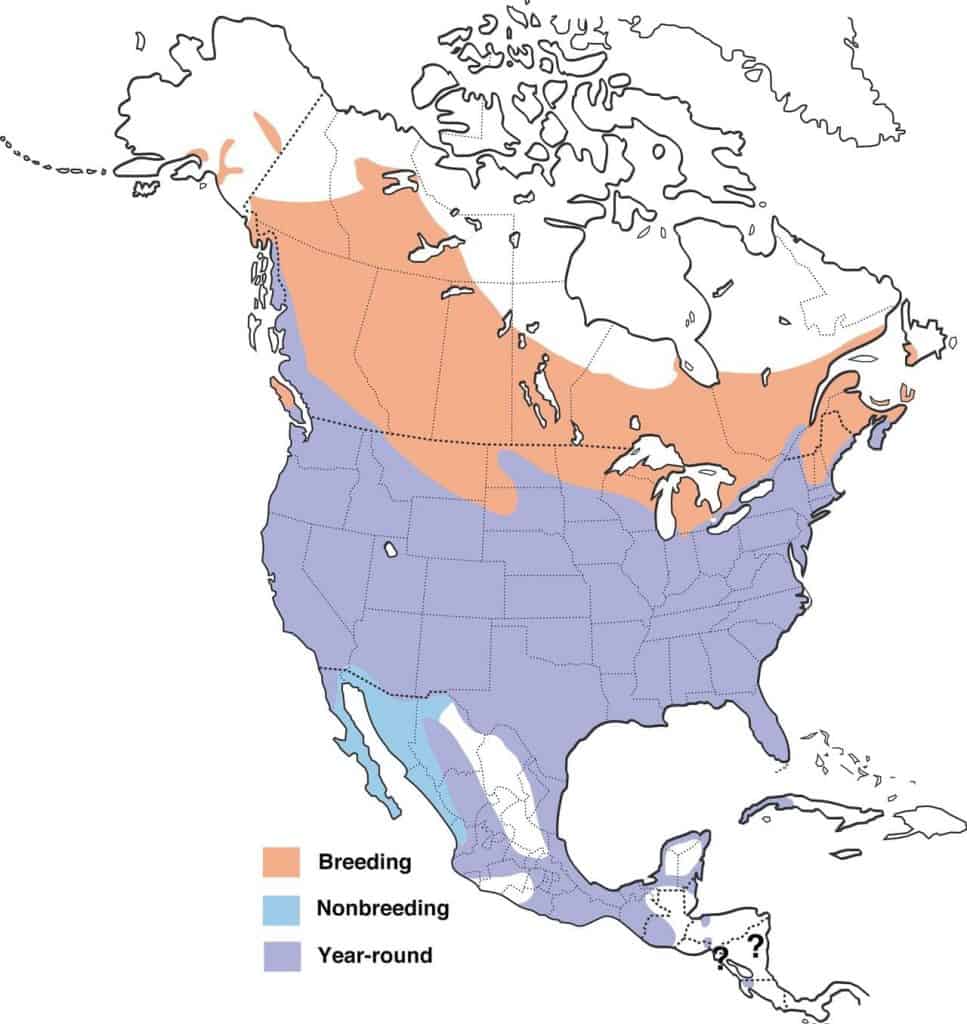
Varied Thrush
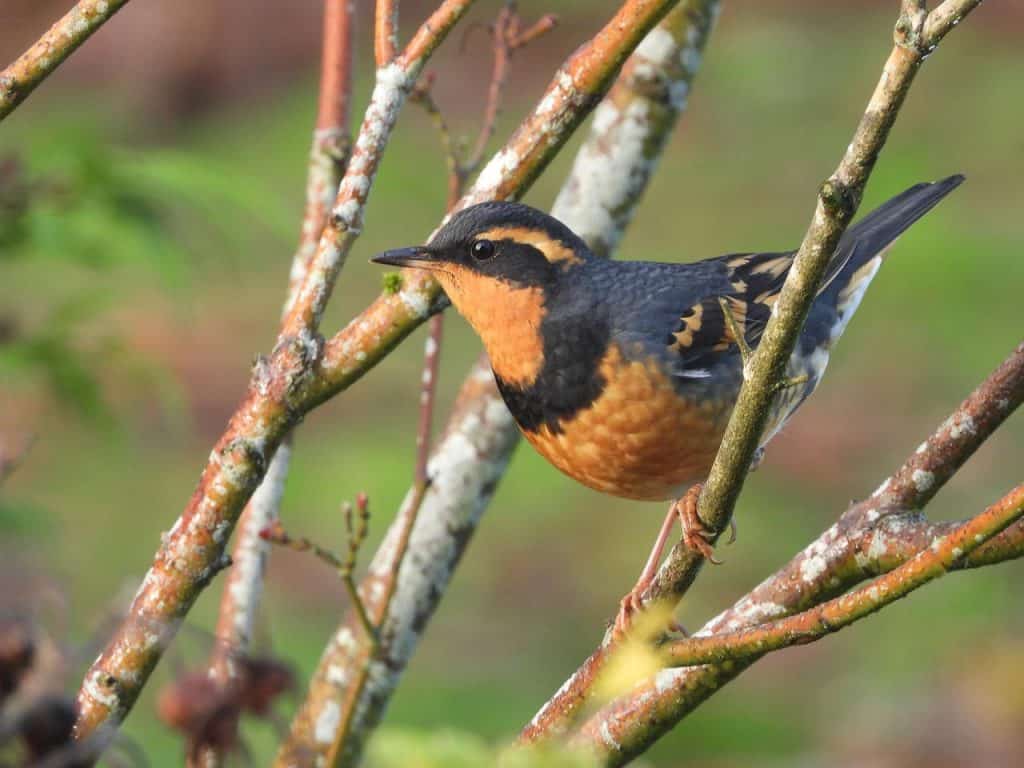
| Appearance | Varied thrushes are large birds about 9 1/2″ long. They are orange underneath except for the black band across the breast. Orange also stripes each side of the head above the eyes. Black back, head, and weaved with orange on the wings. The female is the same except brown instead of black. |
| Diet | Insects, berries, fruits, and nuts. |
| Feeder Food | May forage for food beneath a feeder. |
| Habitat | This bird prefers moist coniferous and mixed forests with a closed canopy. |
| Nesting | Nest: They nest in a conifer 4-20′ up. Females choose the location and build the nest, including layers of moss, mud, twigs, leaves, and grass. Broods: They have 12-broods/season Clutch: 1-6 eggs/brood Egg color: Pale sky blue with occasional dark-brown speckling. Egg size: 1.1 – 1.4 inches by 0.8 – 0.9 inches Incubation: 12 days. Fledglings leave the nest at about 13-15 days. |
Nest & Eggs
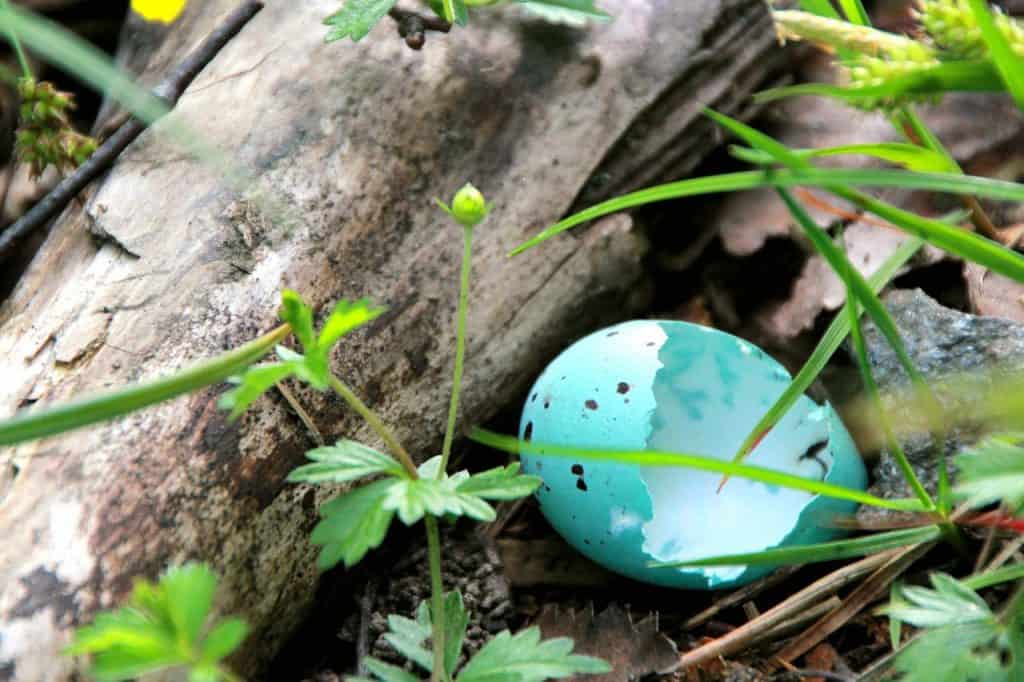
Range Map
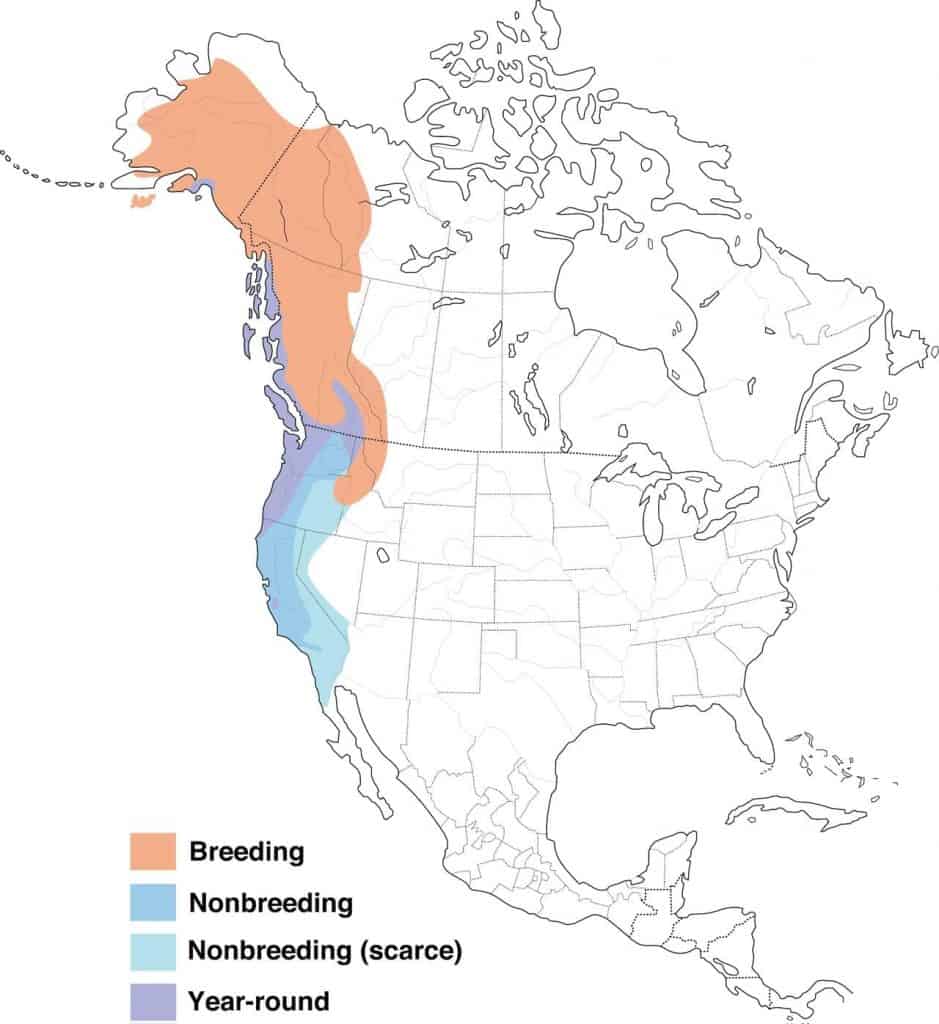
Western Bluebird
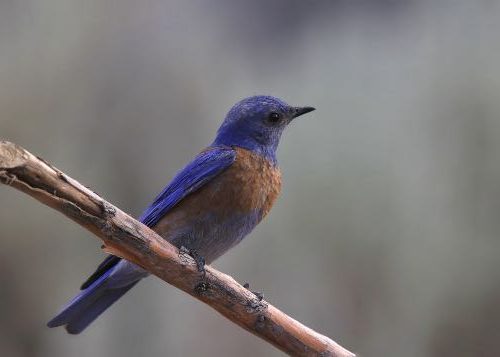
| Appearance | Small bird 7″ long, deep blue underparts, orange-chestnut back and breast. Female gray/blue, light blue wings and tail, and pale chestnut breast. |
| Diet | Insects, fruits & berries. |
| Feeder Food | Mealworms |
| Habitat | Open woodlands especially those with pines and oaks, orchards, and farmland with some trees. |
| Nesting | Nest: Cavity nesters – old woodpecker hold or manmade nesting box. Brood: 2 broods/season Clutch: 4-5 eggs/brood Egg color: Pale blue without blemishes, although sometimes are white Egg size: Length: 0.8-2.4″ x Width: .8″ Incubation: 12-18 days and young fledge at about 20 days. |
Nest & Eggs
Range Map

Common Birds that lay Specific Blue Eggs
OK, the above is a long list of common birds that lay blue eggs. But what if you’re in a hurry and the blue eggs or nest that you are interested in is very specific? I got you. To follow are the blue eggs, or the nest, that have unique attributes along with the bird that lays them. Quick identification is on its way!
Birds that lay blue eggs with brown spots
There are eight birds that lay blue eggs with brown spots. Those species are listed below.
- American Crow
- American Goldfinch
- Blue Grosbeak
- Blue Jay
- Cassin’s Finch
- Northern Mockingbird
- Red-winged Blackbird
- Varied Thrush
what birds lay tiny blue eggs
While the vast majority of bird eggs are relatively small, there is one that can be considered tiny (1/2″ in length or less). It’s the American Goldfinch.
Birds have small blue eggs
Below are birds that lay small blue eggs. Specifically, blue eggs that are less than 1″ in length (which includes tiny eggs).
- American Goldfinch
- Blue Grosbeak
- Cassin’s Finch
- Eastern Bluebird
- House Finch
- Lesser Goldfinch
- Western Bluebird
what birds lay blue-green eggs
Below are birds that lay blue-green eggs.
- American Crow
- American Robin
- Gray Catbird
- Northern Mockingbird
- Red-winged Blackbird
what birds have bright blue eggs
Below are birds that lay bright blue eggs.
- American Crow
- American Robin
- Gray Catbird
which birds have pale blue eggs
Several birds lay pale blue eggs. They include:
- Blue Grosbeak
- Blue Jay
- Eastern Bluebird
- European Starling
- House Finch
- Lesser Goldfinch
- Mountain Bluebird
- Varied Thrush
- Western Bluebird
what birds lay blue eggs on the ground
The Great Blue Heron and Blue-Footed Booby lay their blue eggs in a nest that rests on the ground.
FAQs
Are you craving more information about what birds have blue eggs? Here are some of the most frequently asked questions on the topic.
Do sparrows have blue eggs?
House Sparrows occasionally have light blue eggs but usually have light white or green-white eggs. These eggs often have spots of gray or brown.
Do Robins Lay Blue Eggs?
Yes, American Robins lay bright sky blue or blue-green eggs. Their eggs do not have spots or markings and are about 1.1″ long x 8″ wide.
Conclusion
There are more than 20 species of North American birds that lay blue eggs that range from pale to bright blue to blue-green. And many with their own unique markings. Hopefully, you were able to identify the blue egg you’ve discovered with this comprehensive guide.
Happy Birding!

